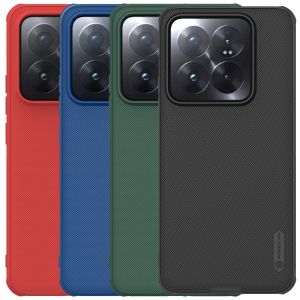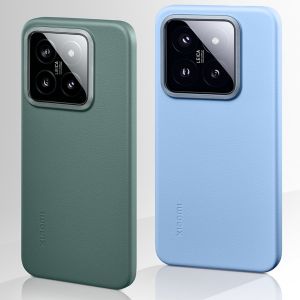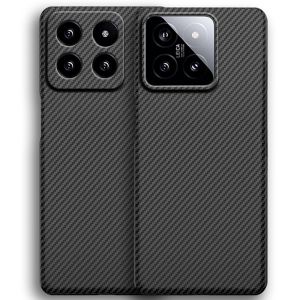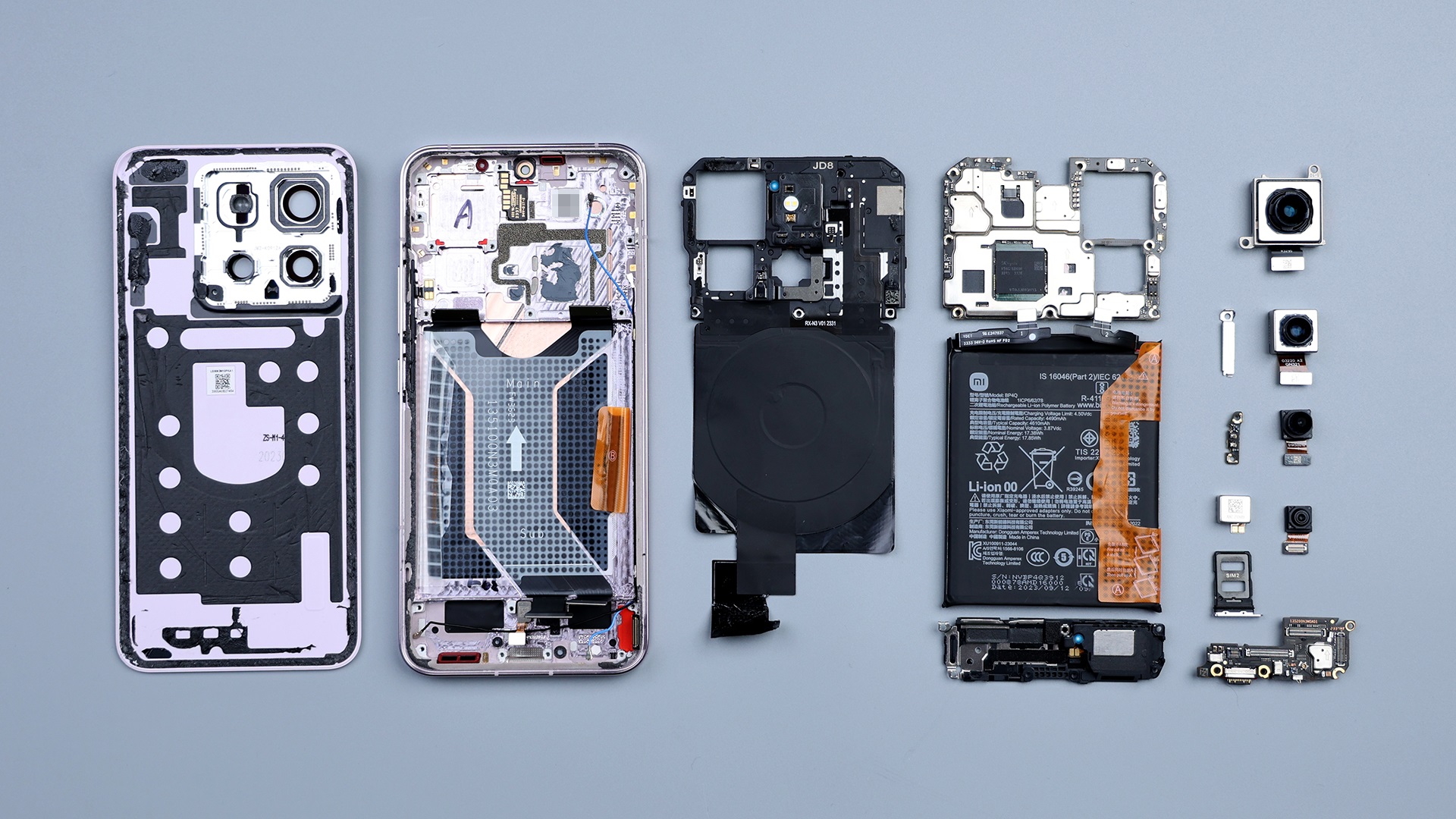
After the Asus ZenFone 10, the Xiaomi 14 is another cell phone that has made me very excited in the last year, especially after seeing the real machine, I like it even more than the ZenFone 10. The Xiaomi 14 has a compact body, excellent grip and one-handed control experience, and an extremely minimalist style without any fancy embellishments, which focuses on a kind of purity. If I were to choose a main machine in the near future, the Xiaomi 14 would be a top three player in my mind. It just so happens that I have a pink Xiaomi 14 at hand, they say that the Pro version look at the pile of material, the standard version look at the quality, today we will take it apart, to see this new Xiaomi digital series of standard version, material workmanship and internal structure is what kind of.
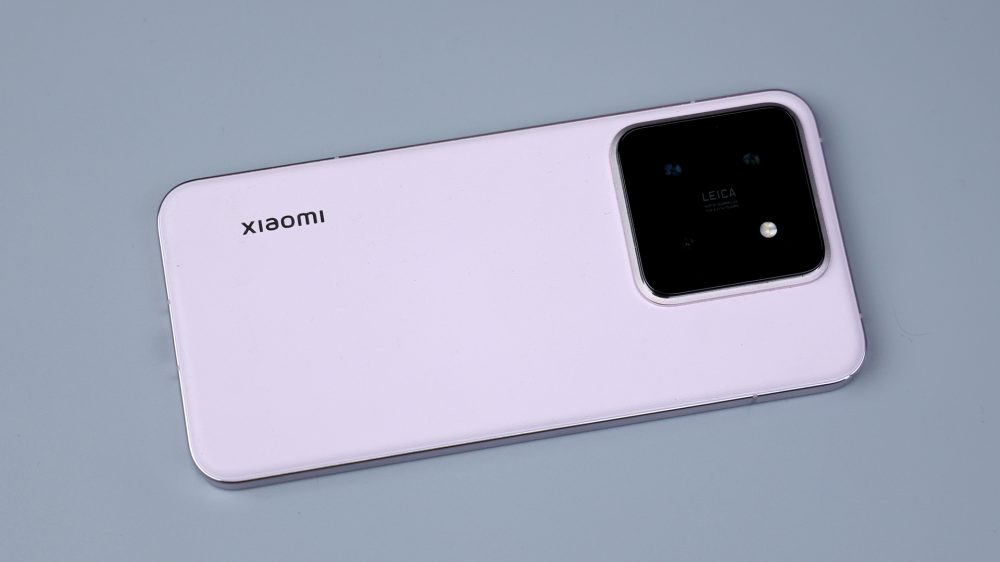
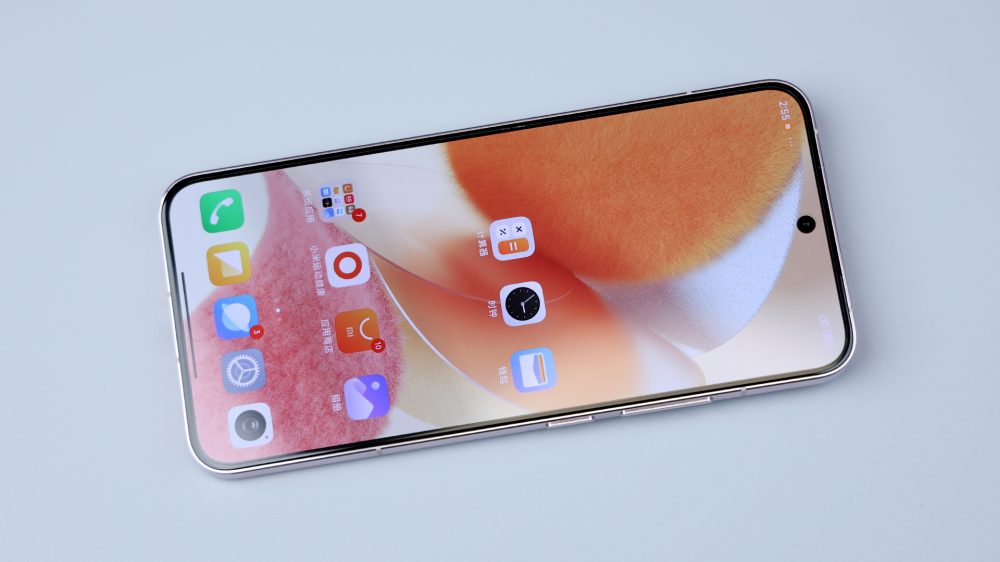
The following officially began to disassemble, shut down the machine and remove the bottom of the SIM card tray, the outer edge and hollowed out bezel is made of metal, wrapped with a plastic frame, the edge of the black rubber ring to play a dustproof and waterproof sealing effect.
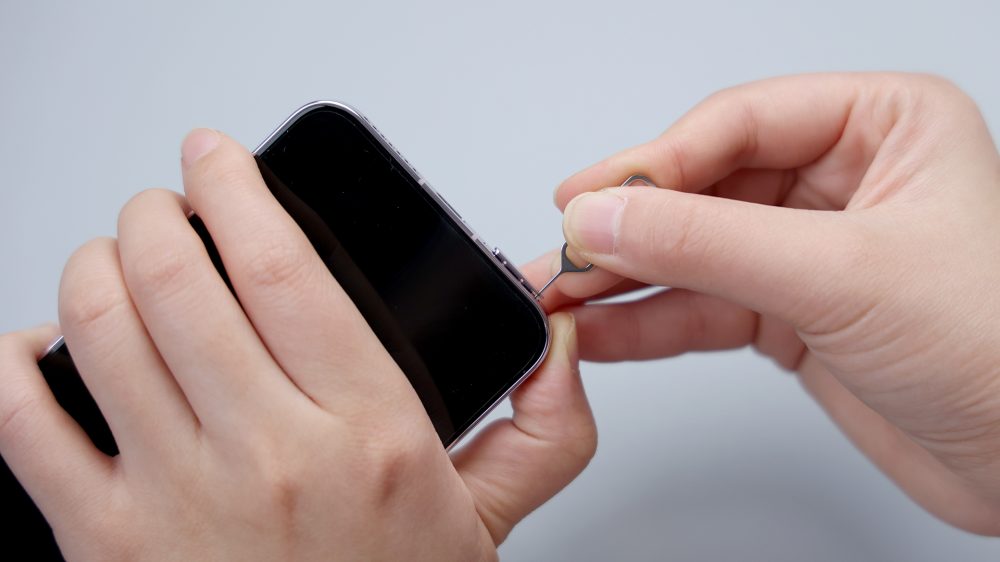
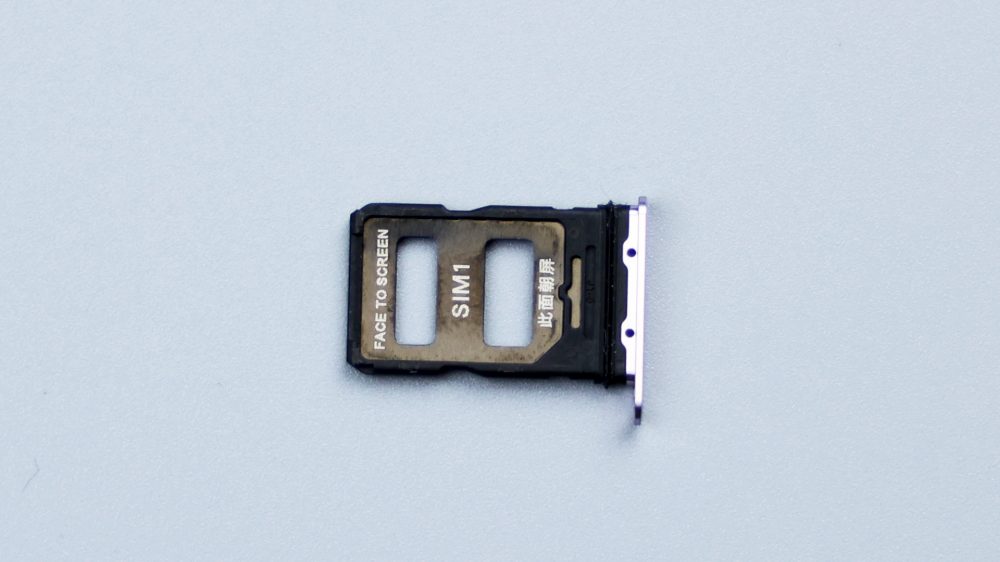
Heat the back cover of the phone for 3 minutes, use a thin metal warping piece to open a break in the corners, replace the plastic warping piece, and little by little sweep away the surrounding sealant. This should be the best back cover I've encountered recently, except for the corners of the reinforced position, the rest of the phone is basically no effort.
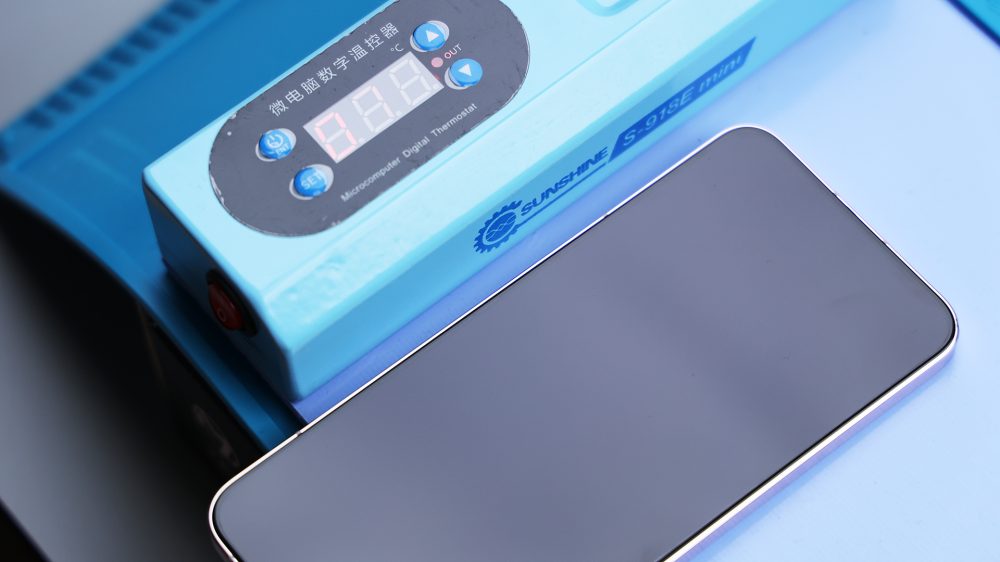
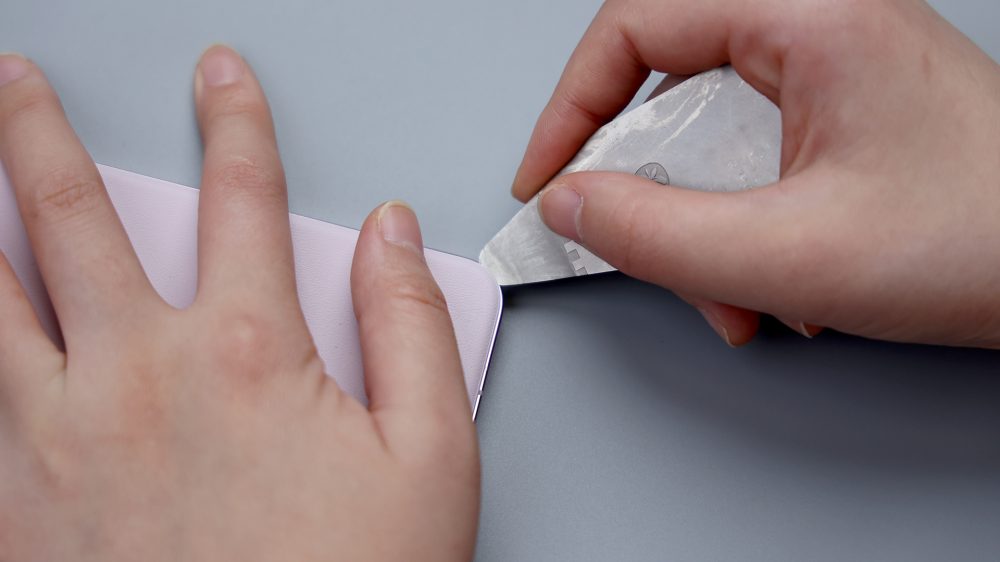
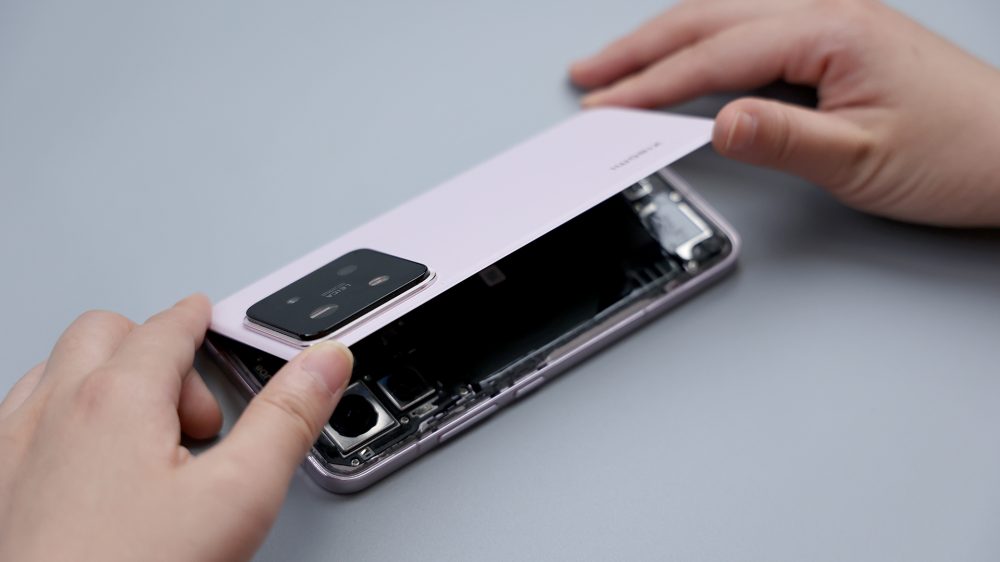
The reason why the back cover is good to remove, because the surrounding circle of adhesive is not particularly wide, the adhesive is soft, relatively easy to clean.
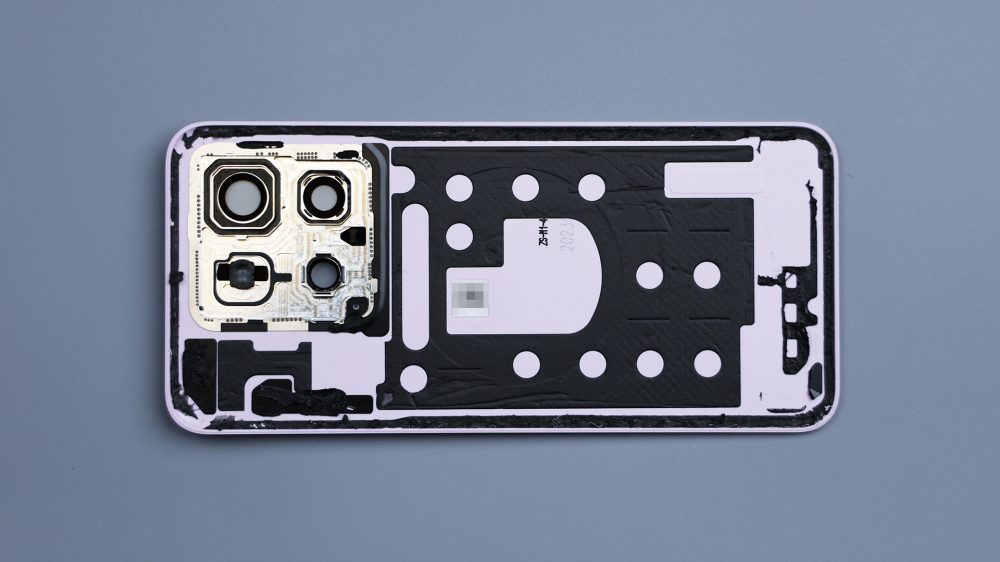
All four corners of the inside of the back cover have added separate spots to assist in fixing the back cover, and the stickiness of these adhesives is obviously much stronger than that of the surrounding ones. The main body of the back cover of this pink version of the Xiaomi 14 consists of two parts: the pink plastic lining that holds up the entire back cover, which can be interpreted as the overall frame, and a complete layer of vegan leather on the outside. Quad-curved back cover with rounded curves, the surface of the lining forms a very shallow groove, and the vegan skin covers it, which is held in place by a large amount of adhesive, and from the edge of the back cover, you can see the wrapped edges of the outer edge of the lining, which is tightly adhered to the outer edges of the vegan skin.
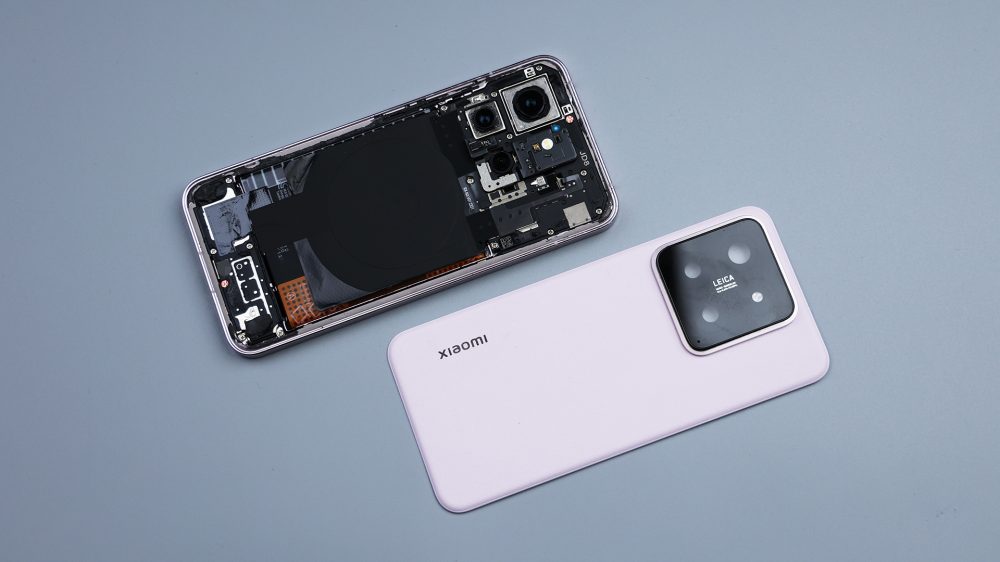
The overall back cover is very thin, and due to the material properties of the plastic and vegan leather, it is very flexible and malleable, and can be bent and deformed with a twist of the hands.
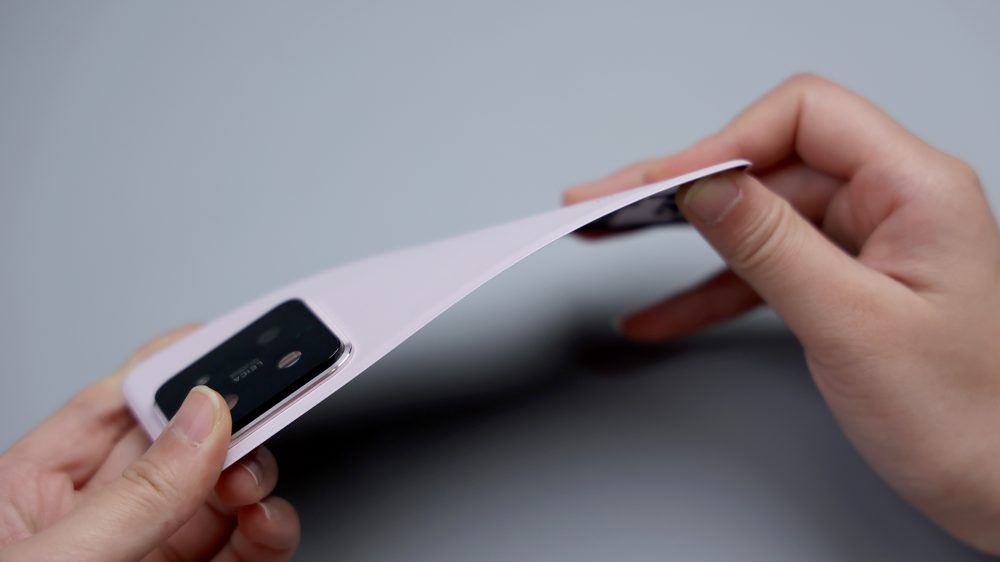
The inside of the back cover, to the left of DECO, as well as the large area in the center, are equipped with cushioning foam.
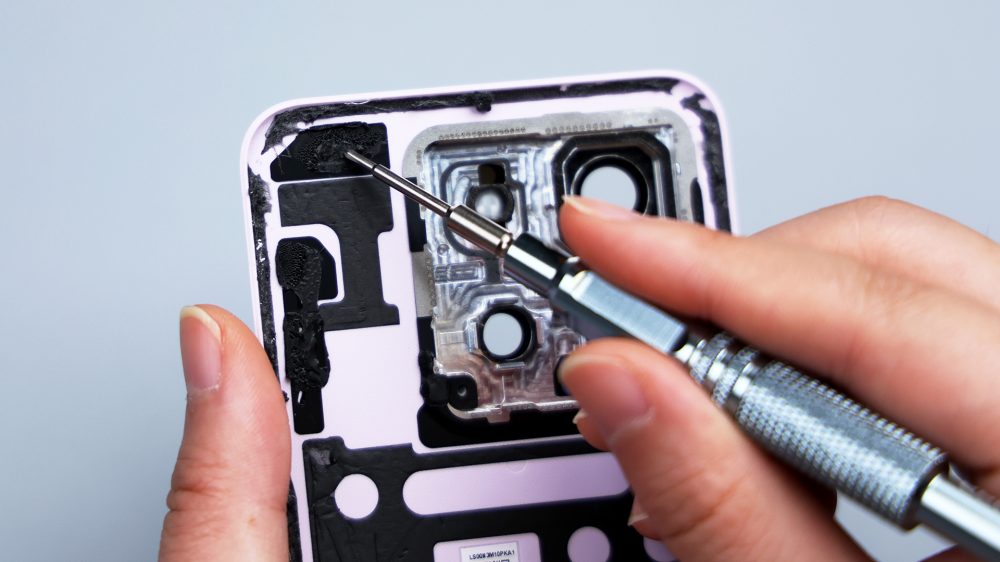
The DECO of the Xiaomi Mi 14 is a bit unusual in that, firstly, it has no plastic lining; structurally, it's a DECO bezel that fits directly over the back cover opening. Secondly, instead of using either a double-reinforced assembly solution of screws + adhesive, or a simple adhesive solution, it opts for a new solution, laser welding + adhesive. This DECO looks like a whole piece of metal, but in fact, it also has a structure, it consists of two parts, one is the lens slot made of metal, that is, the main part of this metal texture and glossy, rounded rectangle, judging from the surface traces, it should be CNC machined.
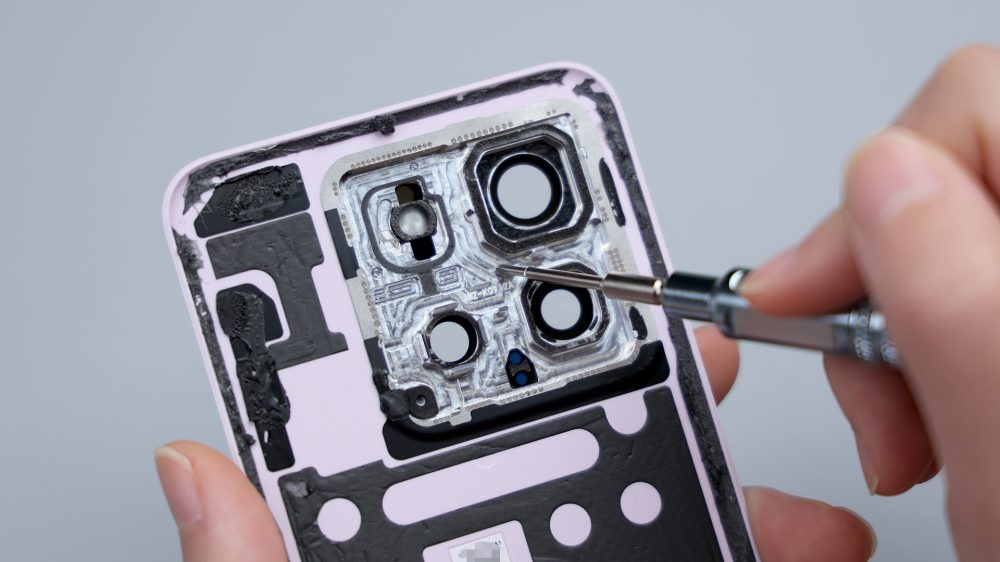
The other part is the metal frame, the rounded rectangular metal ring that is less shiny and textured and slightly yellowed. The two of them were originally two separate parts that were combined together by laser welding to form a whole, and the densely packed dots on the edges of the outer frame are the traces left by the laser welding. Judging from the gaps in the edges and the traces of articulation, the DECO bezel should have been fixed to the back cover by means of adhesive.
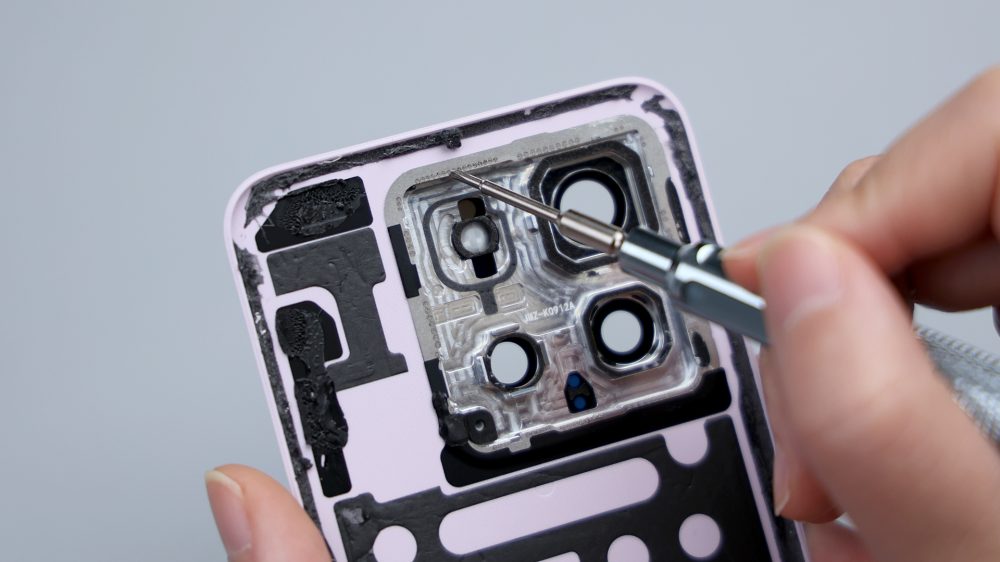
For the Xiaomi 14, the benefit of adopting this design and assembly method is that it can simplify the internal structure of the DECO, and at the same thickness and degree of protrusion, it can reserve more longitudinal space inside the DECO for accommodating the rear triple camera and the supporting components, and there is no intermediate layer to take up the space, which improves the utilization of space. At the same time, it can also, to a certain extent, alleviate the pressure on the horizontal and vertical space inside the main body of the phone. Compared with the adhesive process, laser welding is more solid and airtight, which can improve the performance of dustproof and waterproof.
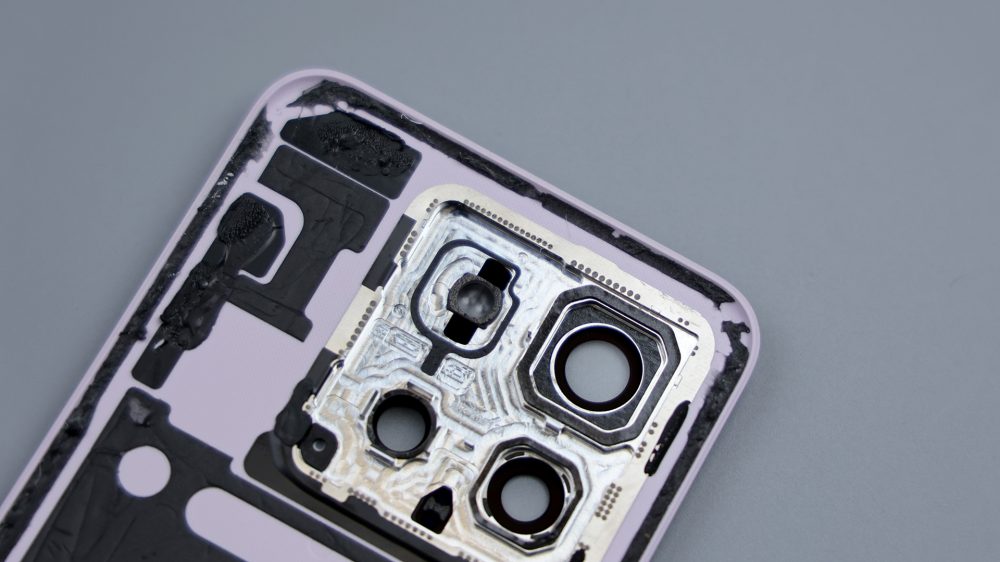
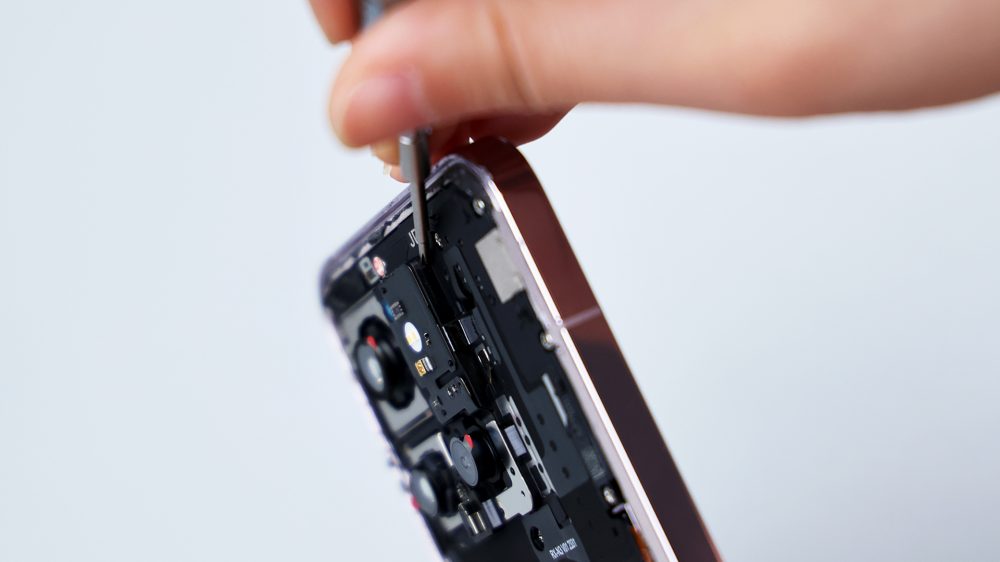
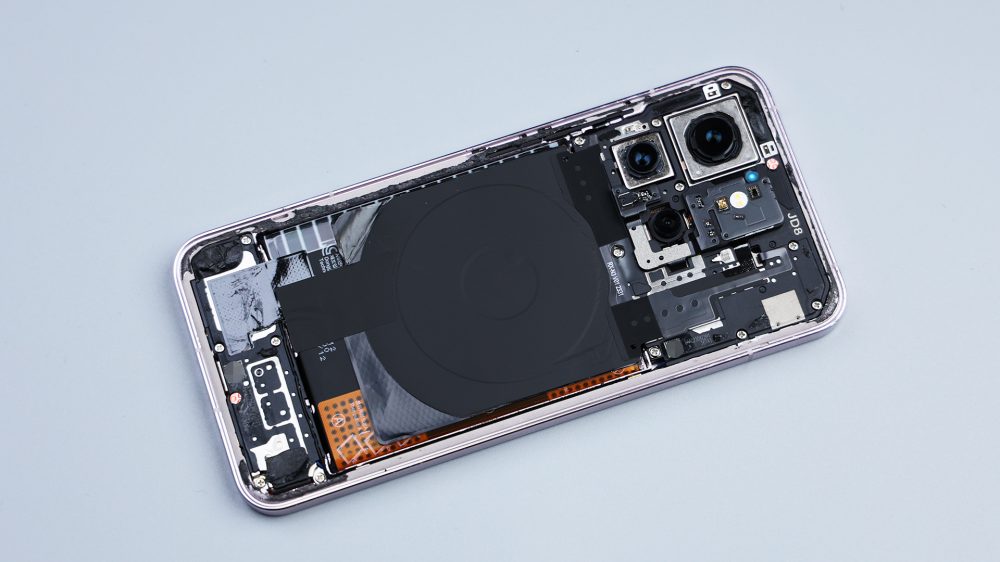
Compared with DECO, which has a plastic liner and adopts a double fixing scheme, this design of the Xiaomi 14, in which the lens and cover directly face the metal groove, looks slightly brown, however, it does not affect the function and use, and it will not cause any damage to the lens. Because, all the lens corresponding openings, including the flash opening position, are equipped with a foam ring, responsible for cushioning protection. The round hole in the lower left corner corresponds to the rear noise-canceling microphone, and the opening in the center down corresponds to the laser focus module, which are also protected by foam.
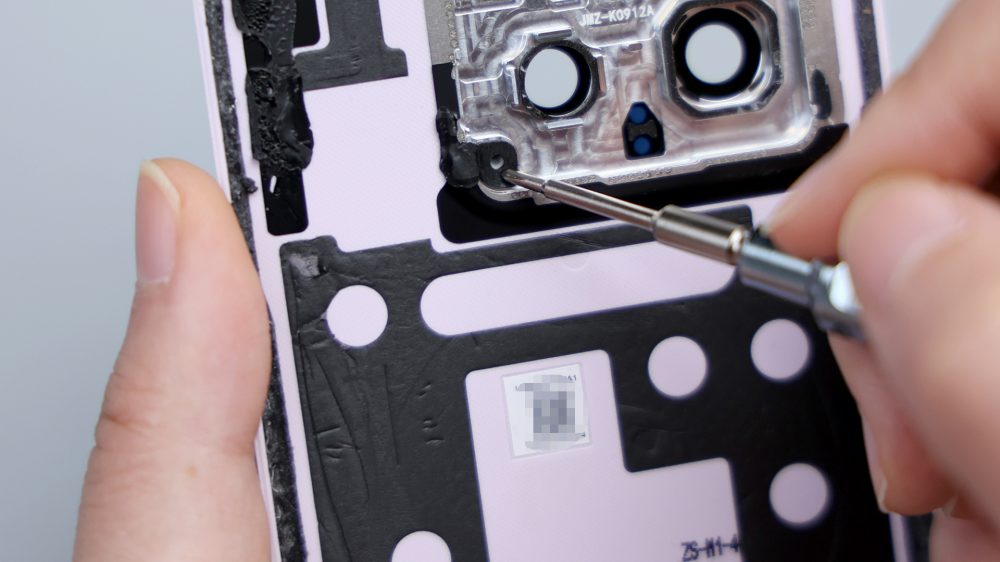
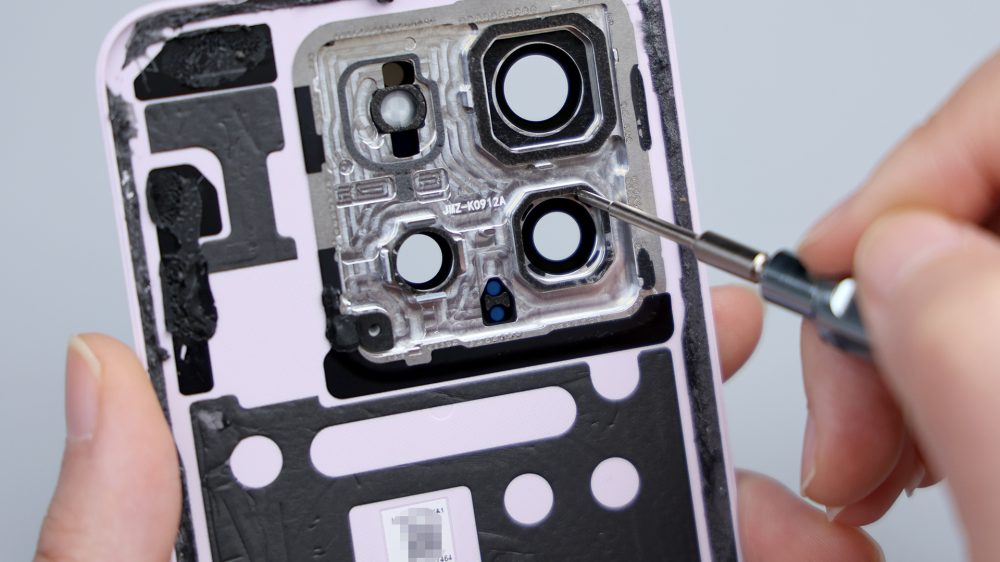
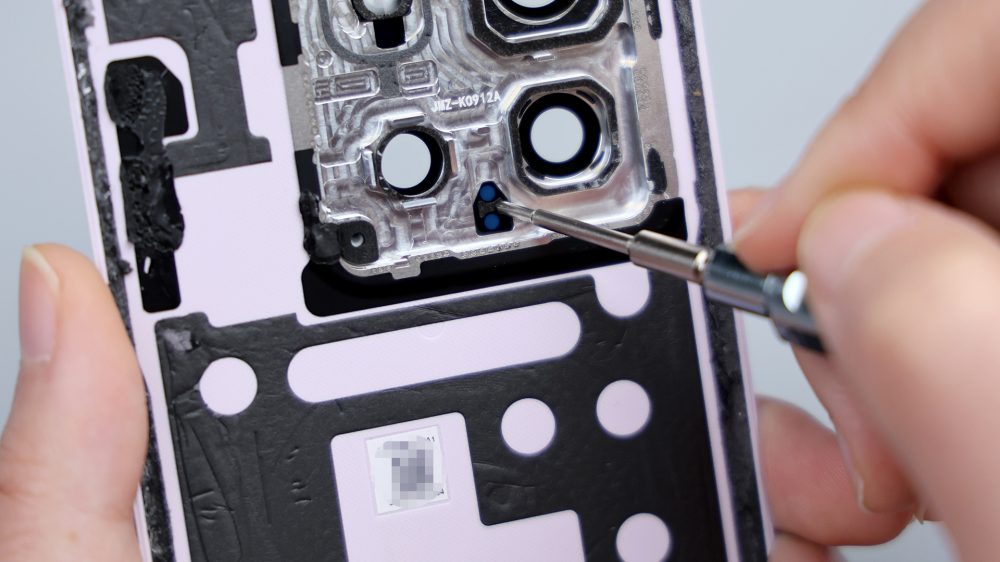
After the back cover is done, it's time for the main show to begin. The internal structure of the device is still in the usual Xiaomi style, but with so many parts crammed into such a small body, it looks a bit crowded and constricted in any case.
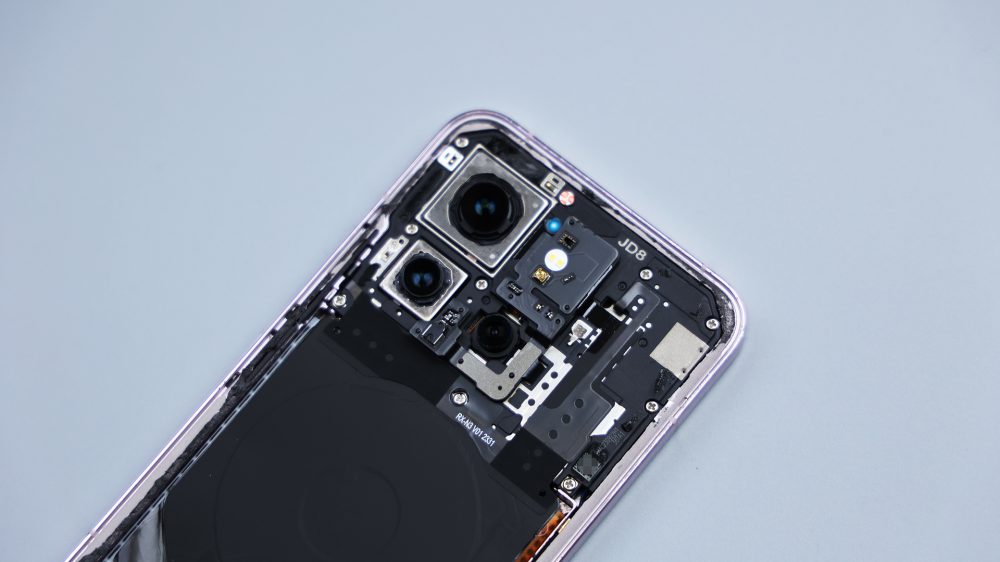
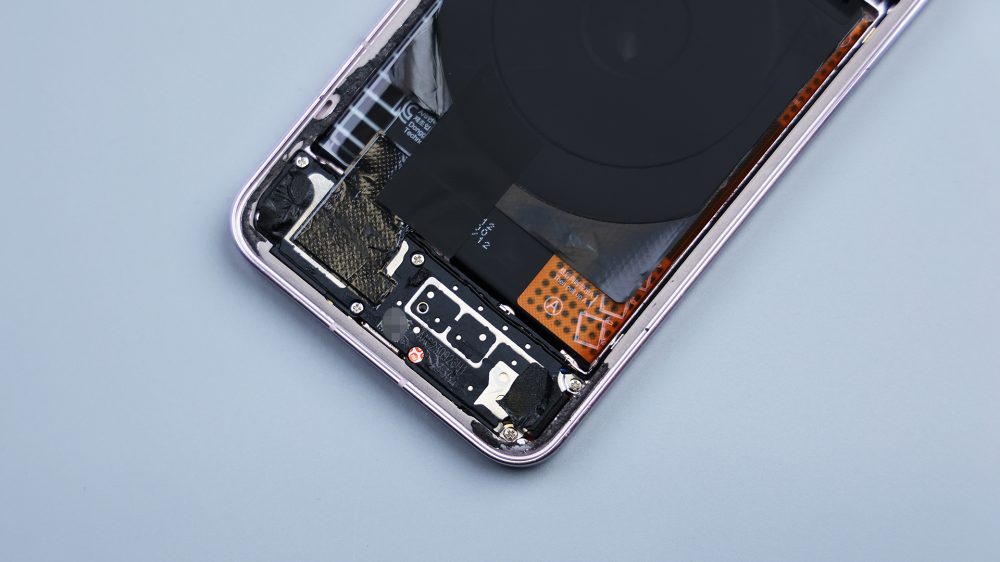
The most eye-catching also counts the rear camera area, three lenses are hard work, especially the large main camera, looking at the bluff. Flash is located on the right side of the main camera, using a dual-LED bead configuration, it is above the rear ambient light sensor, below the infrared emitter, most of the infrared of the previous Xiaomi phone is integrated in the motherboard, placed on the back is still relatively rare.
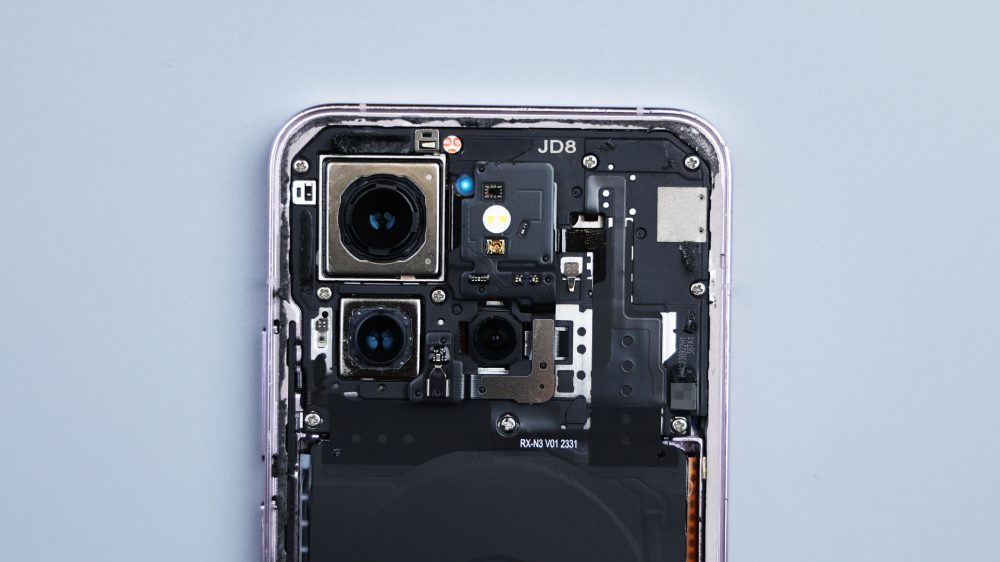
From the side, this part is obviously padded, in order to try to be level with the lens, combined with the layout of the front, it is guessed that the speaker should be integrated underneath.
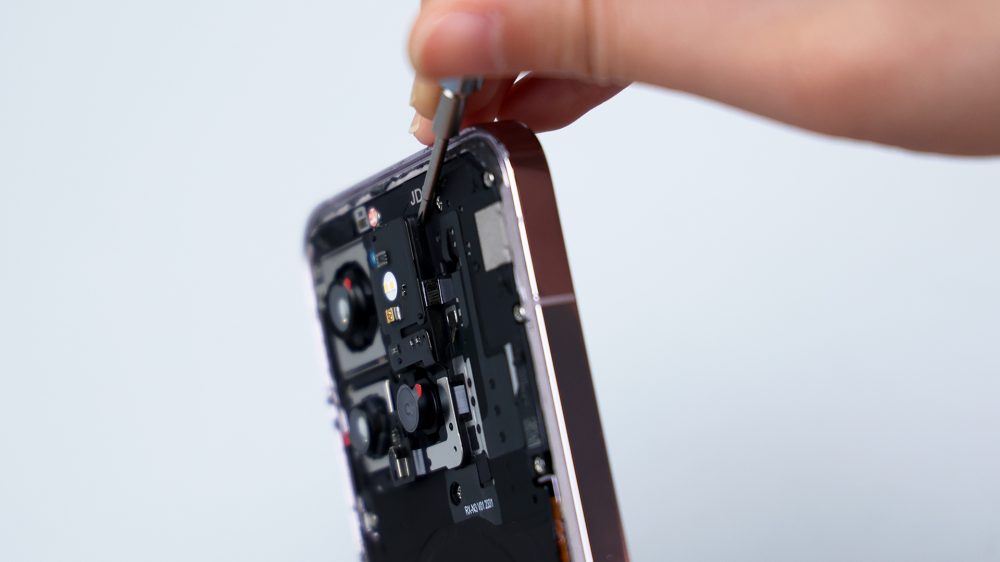
Sandwiched between the telephoto and ultra-wide-angle lenses is the laser focus module, and the round hole at the bottom right of the ultra-wide-angle lens corresponds to the rear noise-canceling microphone.The NFC coil runs down from the top right, all the way across the cover to the bottom left, and there's also an antenna on the right side that extends upwards. There's also a metal plate sandwiched in the cover that serves as some heat dissipation and connection conduction. The wireless charging coil is still in the center, above the battery, the Xiaomi 14 supports 50W wireless fast charging and wireless reverse charging, the coil is covered with a graphite thermal paste inside and outside, and extends up and down, where the lower left one extends to the bottom speaker, and also serves as a fixation through adhesive, with a black coaxial cable running through it next to it, and remnants of the adhesive that fixes the back cover can be seen in the corners of the surroundings.
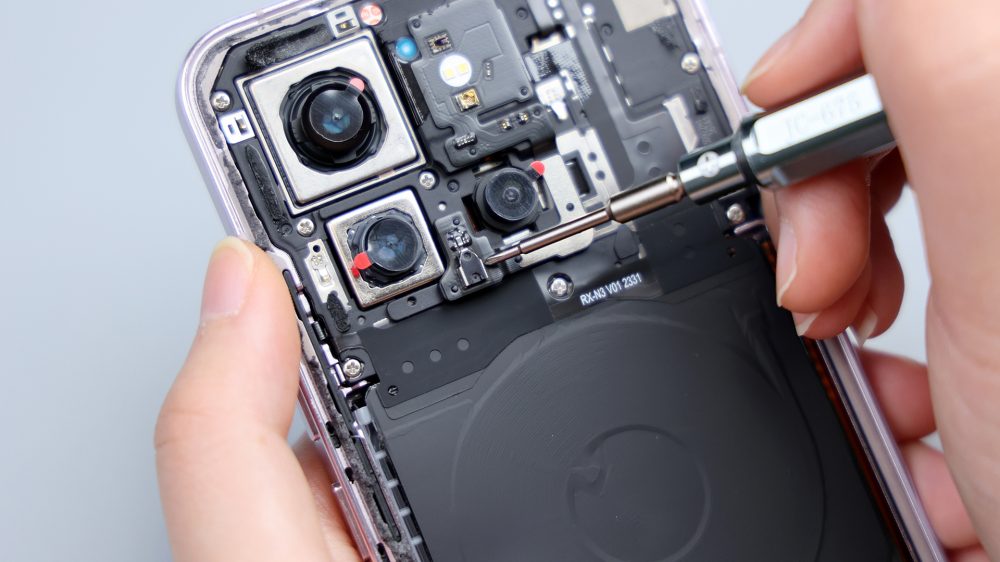
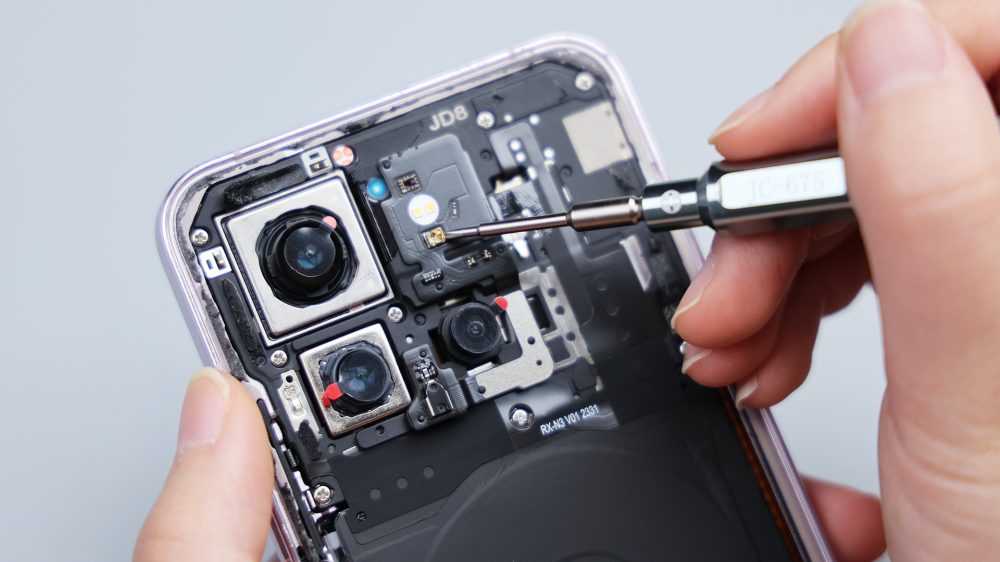
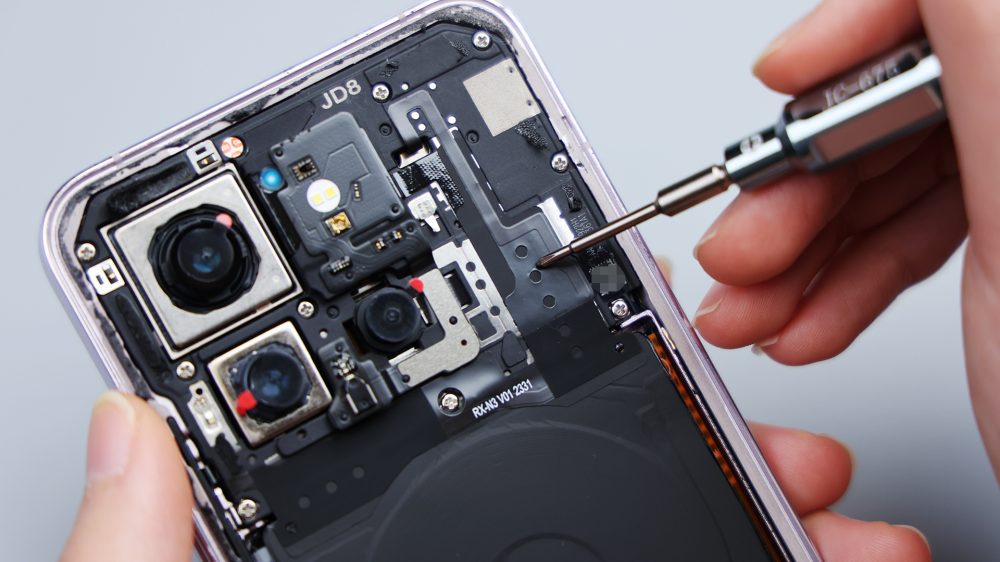
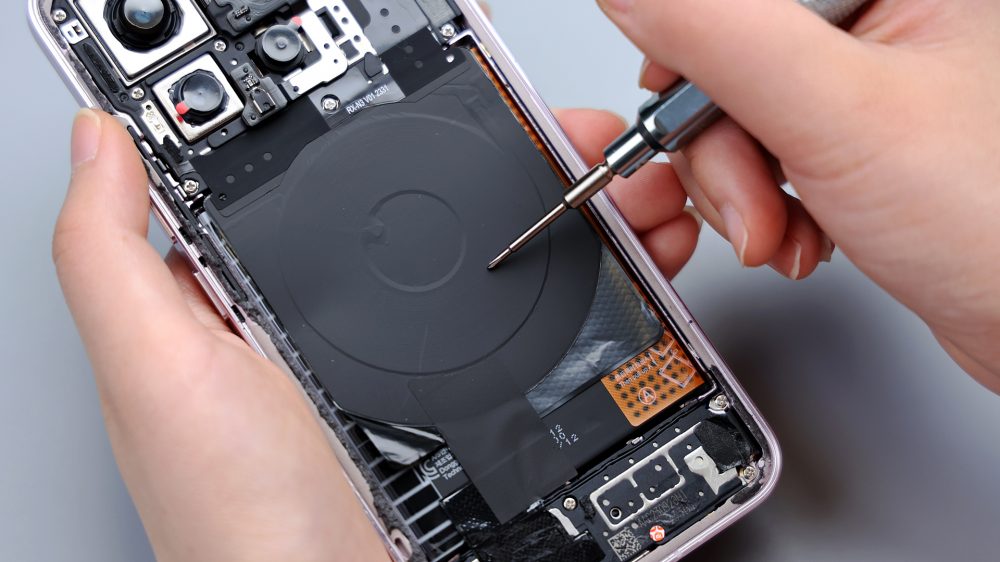
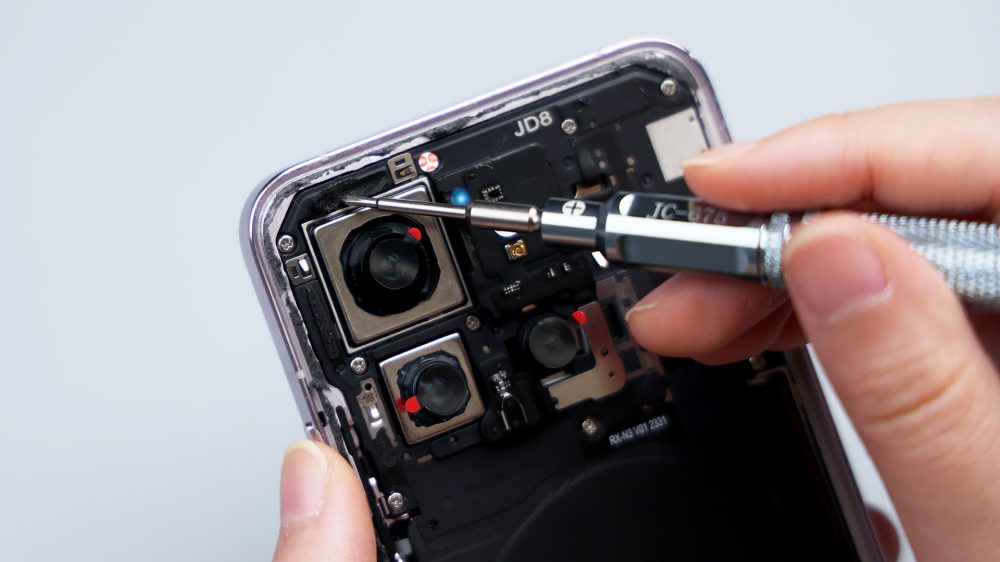
Tear off the graphite thermal paste fixed at the bottom, unscrew all the fixing screws of the cover plate, slowly pry up the cover plate, note that there is still a FPC attached to the back of it, disconnect it before removing the cover plate.
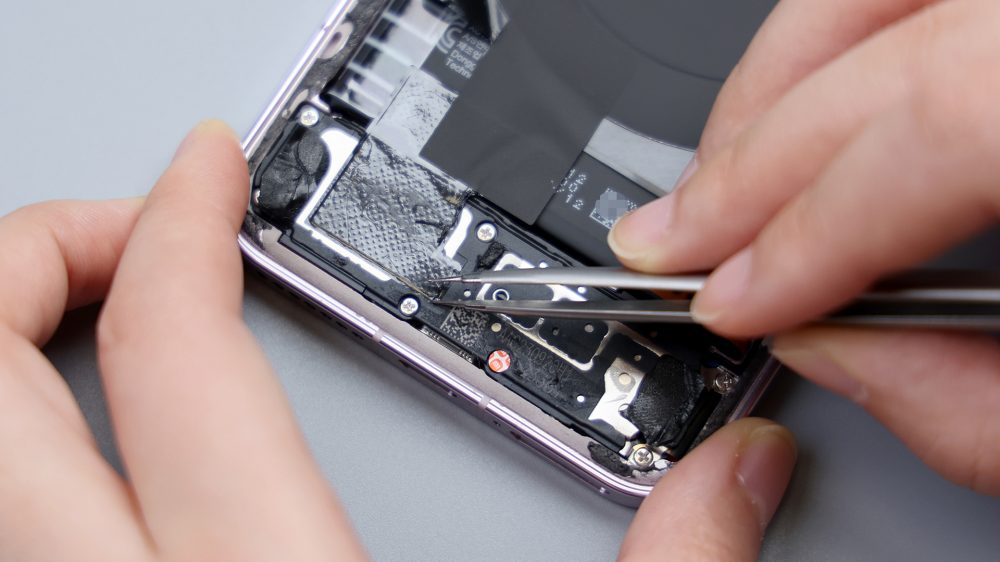
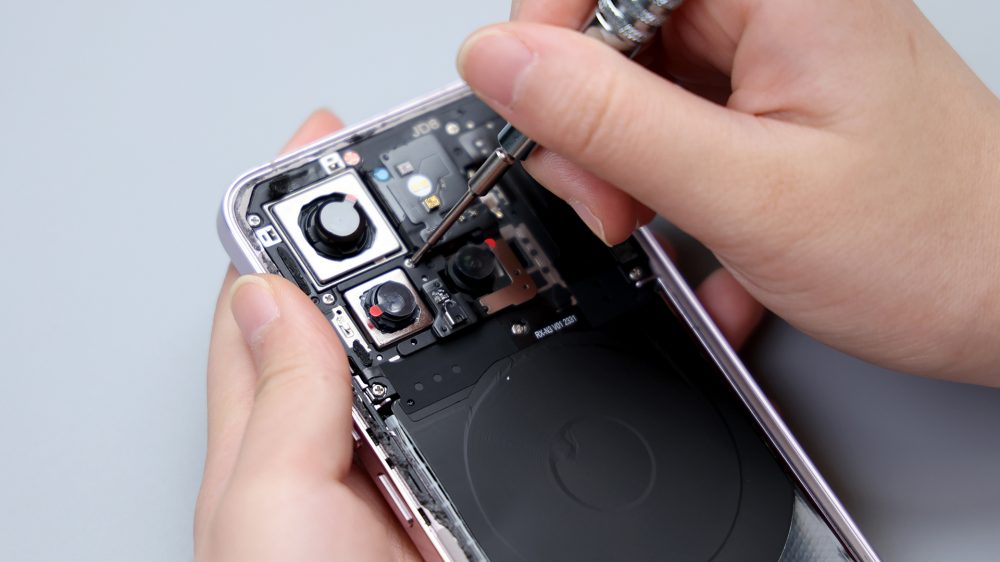
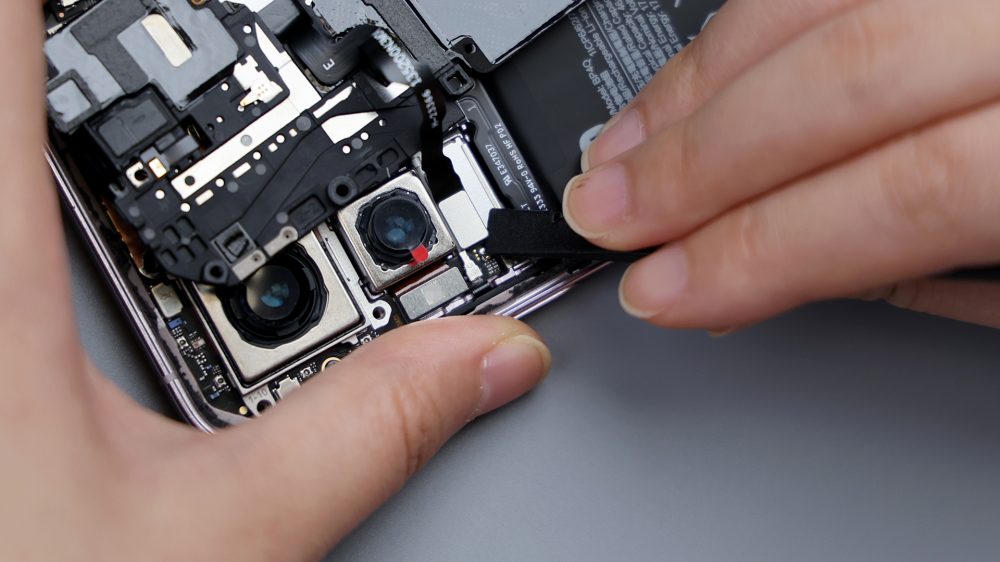
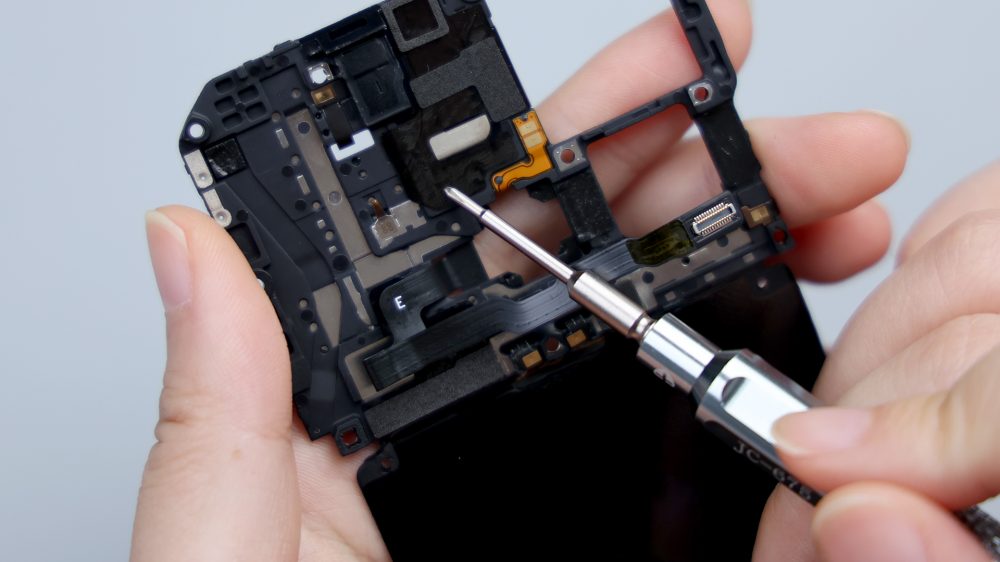
As I guessed before, there is a speaker integrated on the cover, the supplier is Ruixing Technology, 1014 specification, connected to the motherboard through the two contacts in the center, it also takes care of the duties of the earpiece, and the upper left chimney-like channel is responsible for transmitting the sound to the outside.
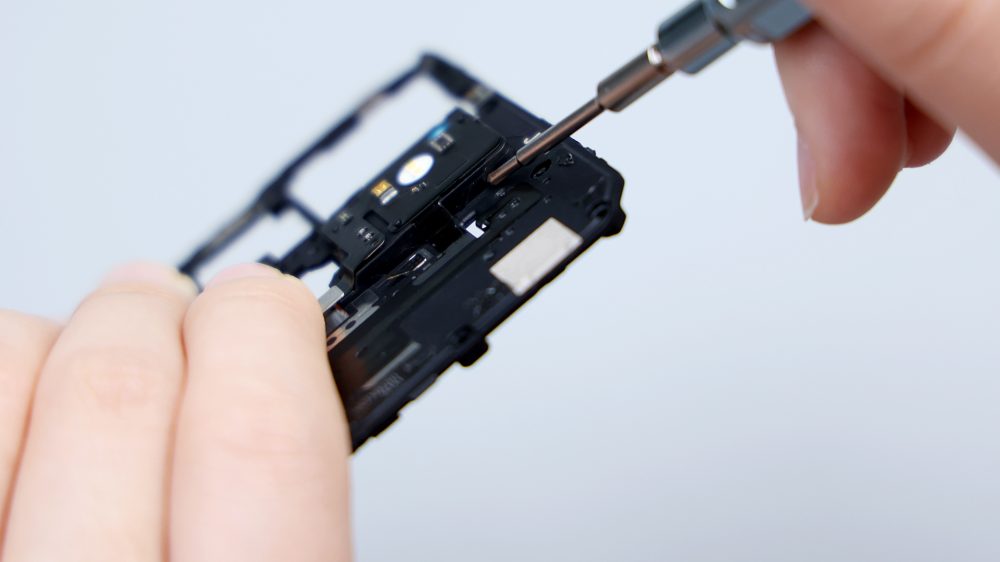
Combined with the front padding, it becomes clear that this design is done very cleverly, housing the speaker and holding up components such as the flash and infrared emitter, no longer a simple combination or splicing, but a perfect match under comprehensive consideration. From a macro point of view, the cover is like a pivotal bridge, bringing them together in a reasonable arrangement, which can be said to be a multi-purpose, with as little space as possible, to solve as many functions and needs, and improve the integration of this area.
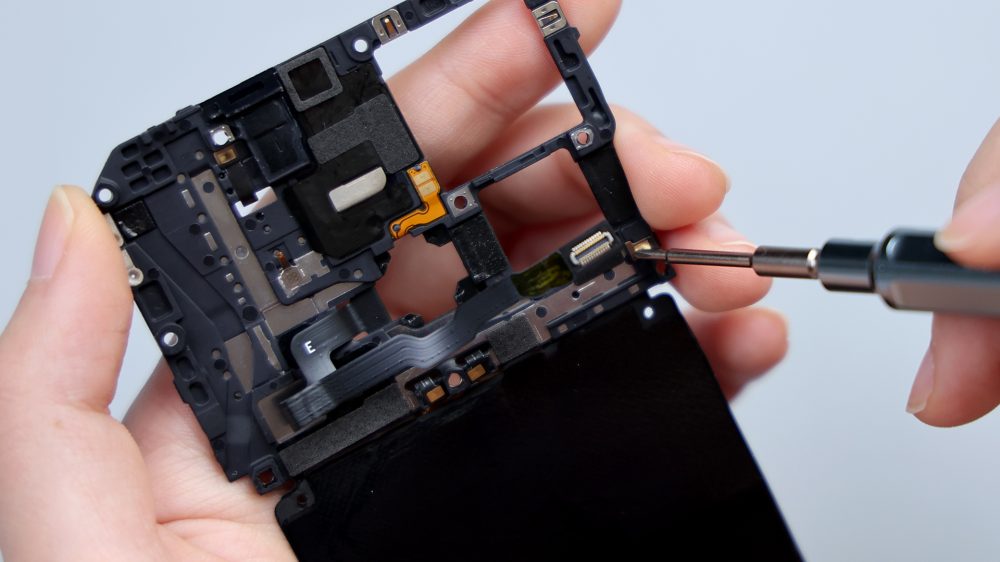
The longest FPC on the inside of the cover plays a very important role, extending outward and connecting components such as the ambient light sensor, flash, IR emitter, noise-canceling microphone, and laser focus module.
Inside the upper left and lower right contacts are responsible for connecting the NFC coil, the bottom two contacts correspond to the wireless charging coil, the back of the speaker has a piece of graphite heat dissipation stickers, the top L-shaped foam corresponds to the main camera and the front lens of the BTB, the square foam ring corresponds to the front lens, the lowest row of foam corresponds to the battery, the main and sub-panel FPC of the BTB, there is a position empty without foam, will be explained in detail when the dismantling later. There is an empty position without foam, which will be explained later in the disassembly. The two pieces of foam in the center and to the right correspond to the BTB of the telephoto and ultra-wide-angle lenses, which play a role in buffering and protection.
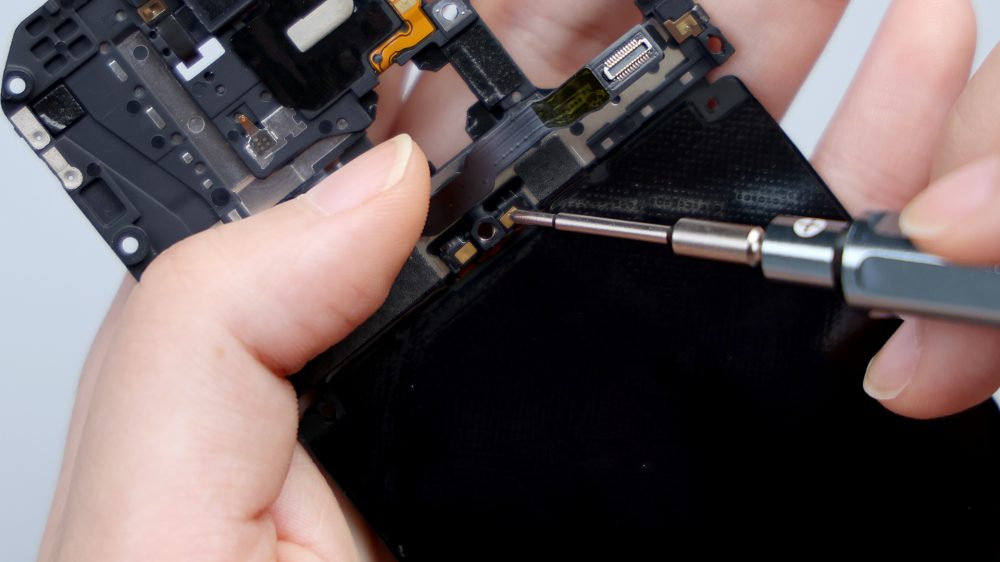
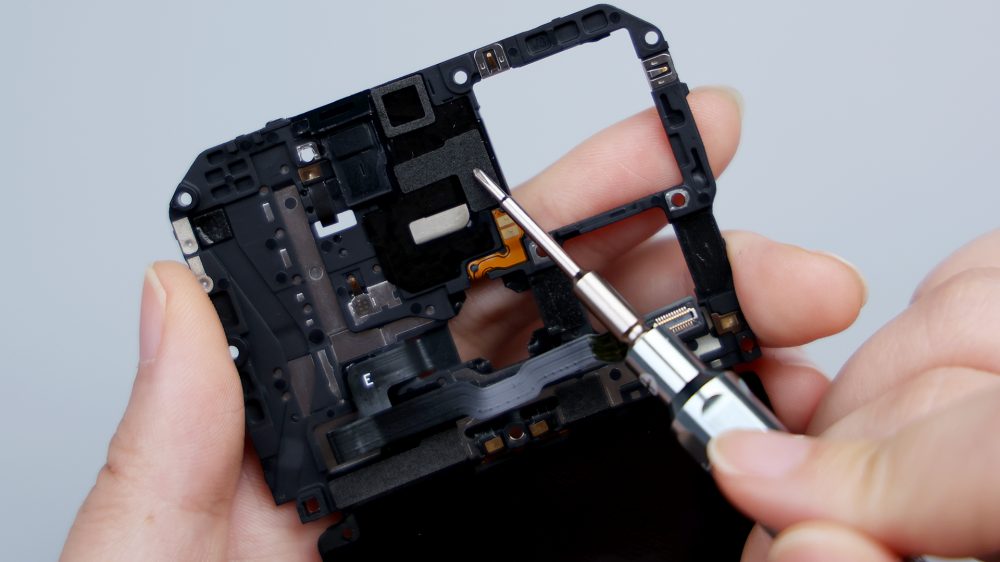
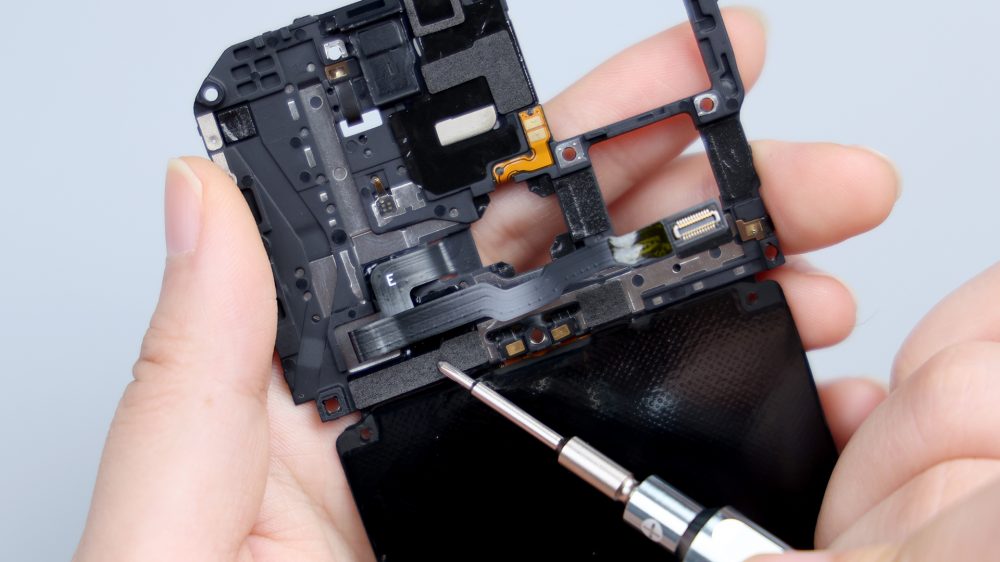
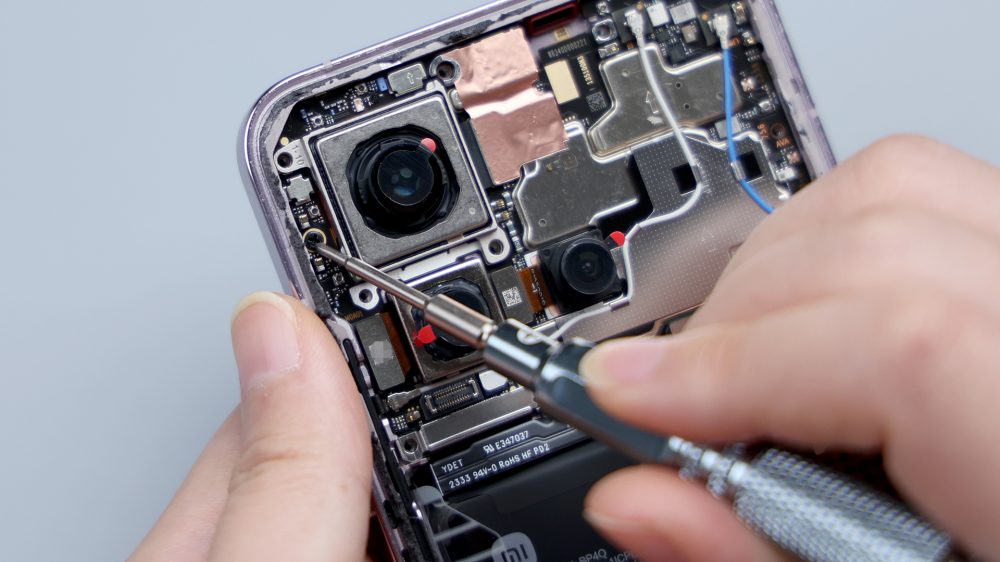
There is a separate fixing screw for the main board, a small piece of copper foil in the upward position in the center covers the front lens and the two BTBs underneath, the red rubber ring next to it corresponds to the channel for the speaker's upward extension, a white coaxial cable on the right follows the route of the NFC coil and runs from the upper right to the lower left side of the main board, the blue and black coaxial cables on the far right connect to the main and secondary boards, and the two BTBs for the batteries are connected to the main board on one side and the other on the right side.
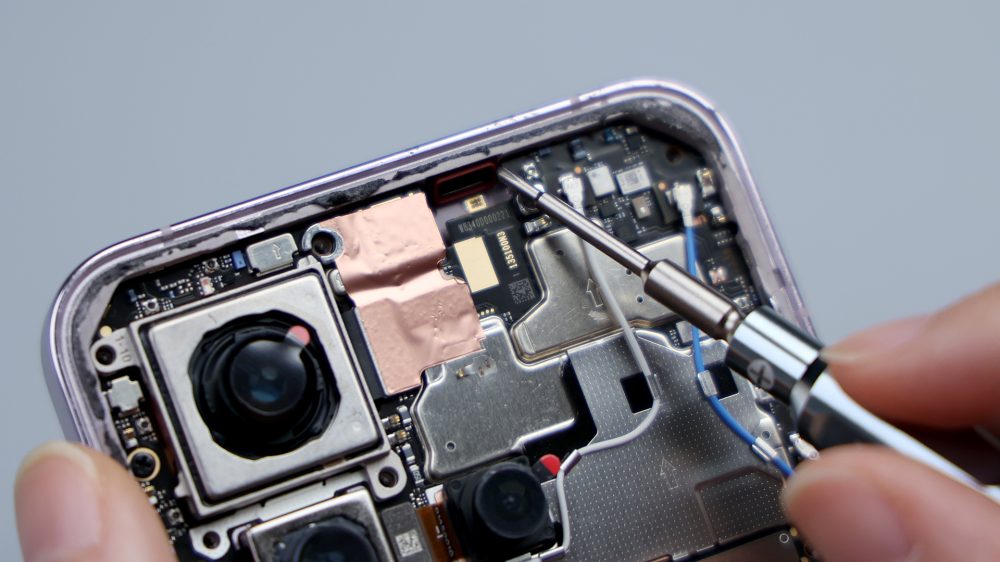
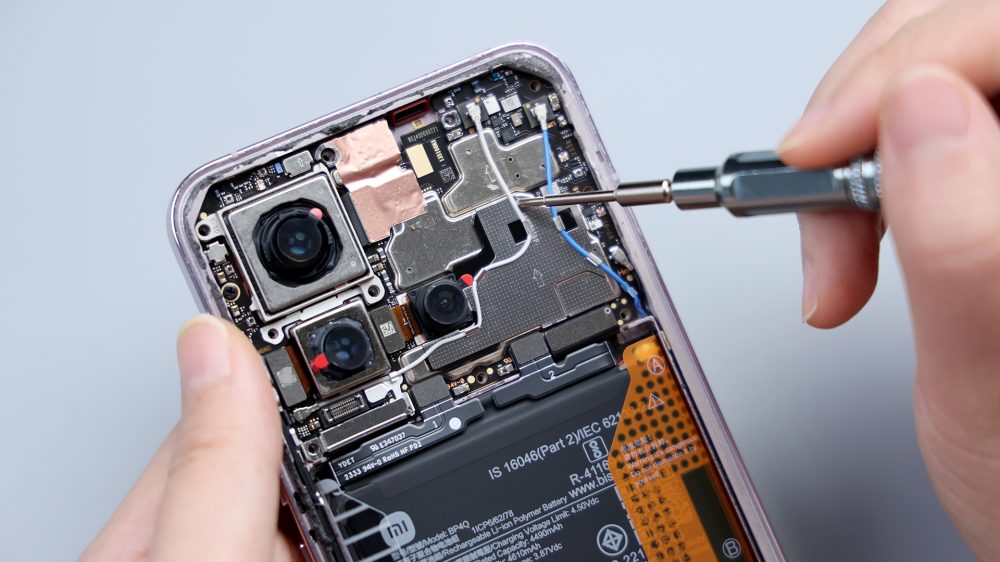
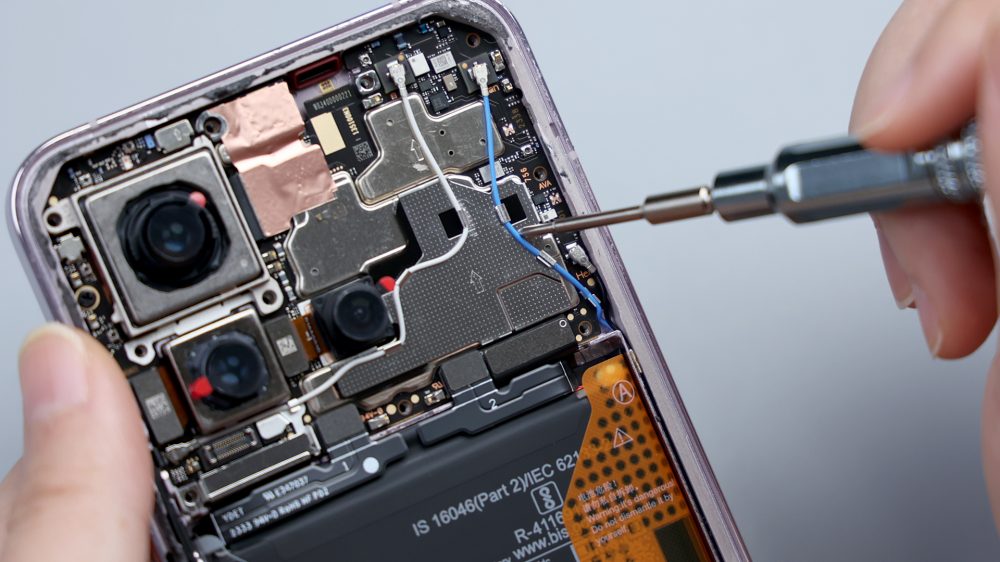
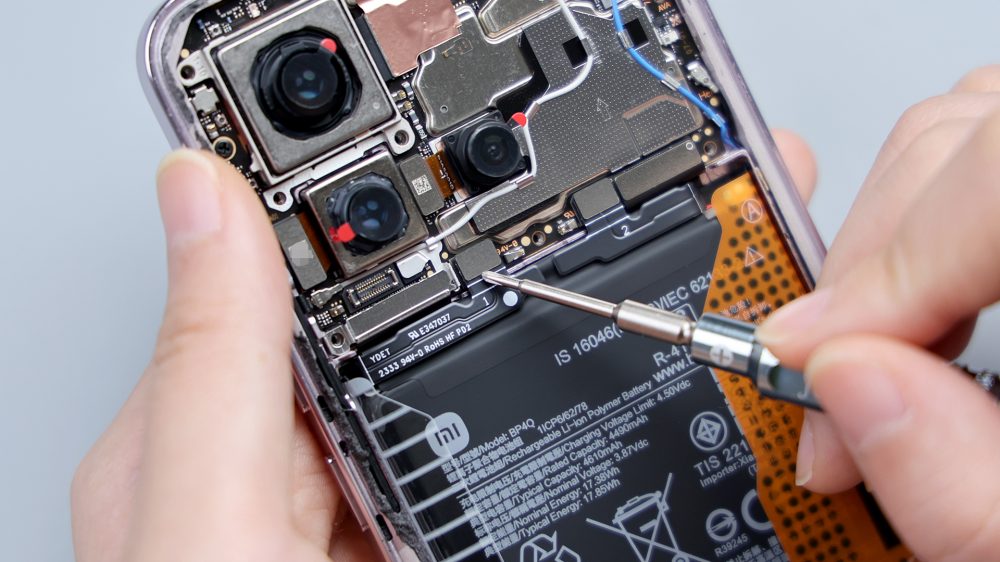
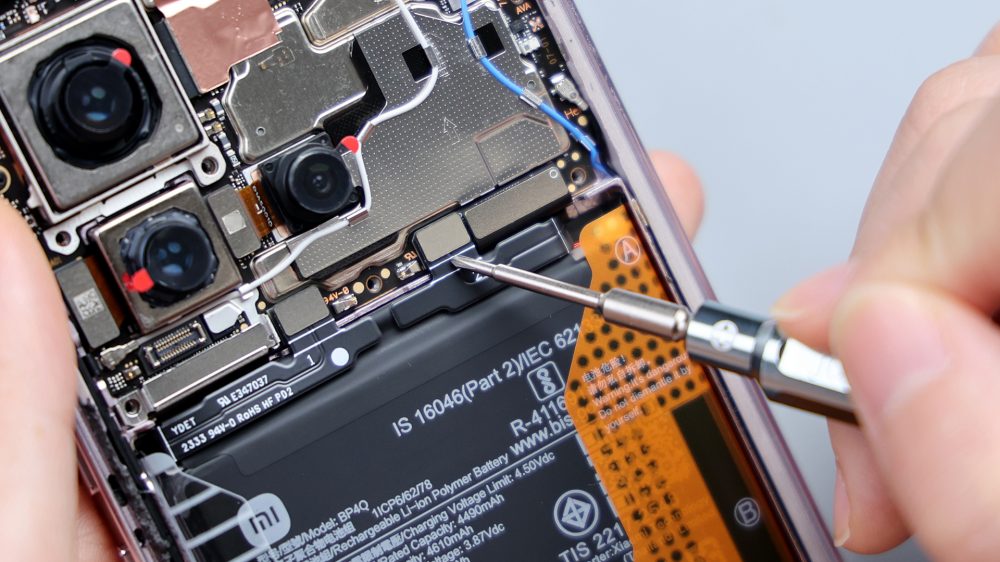
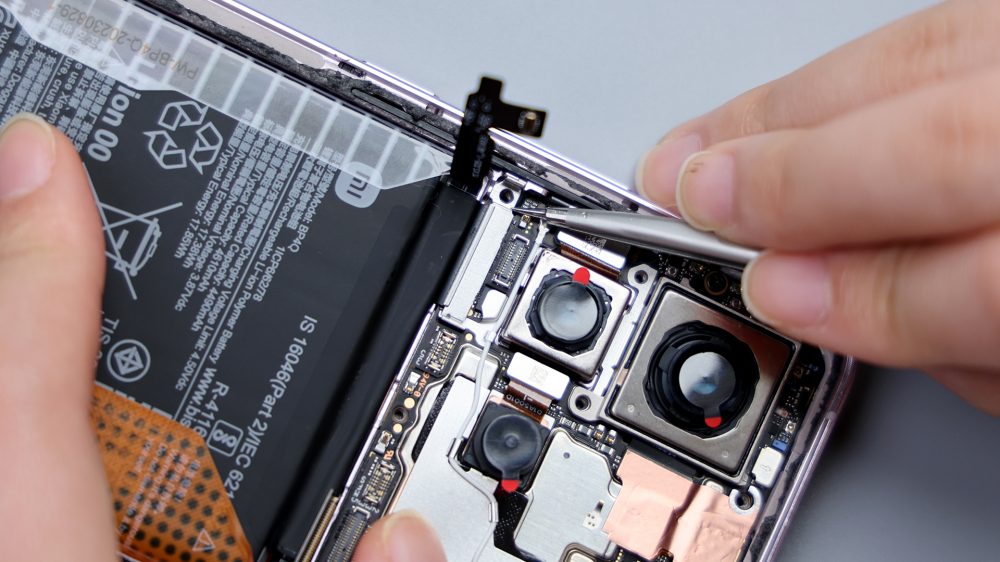
Disconnect the battery, the BTBs of the main and secondary FPCs, and the two coaxial cables on the right side in turn. There is also a BTB pressed underneath the metal sheet as a kind of protection to prevent the interface from disconnecting in case of a drop, that's why it doesn't have a cushioning foam at its corresponding position when you looked at the inside of the cover plate before, pry up the metal sheet and disconnect the BTB underneath it.
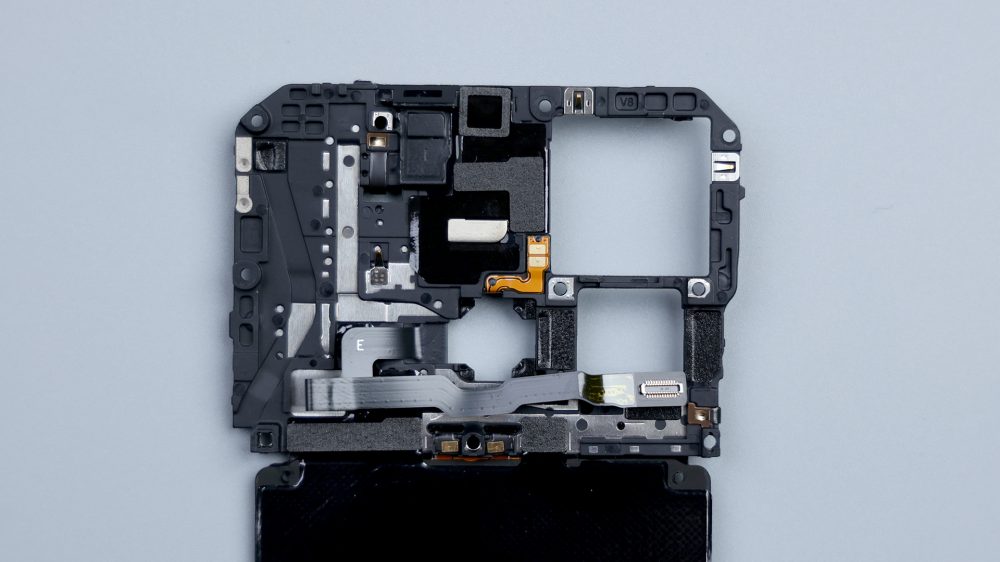
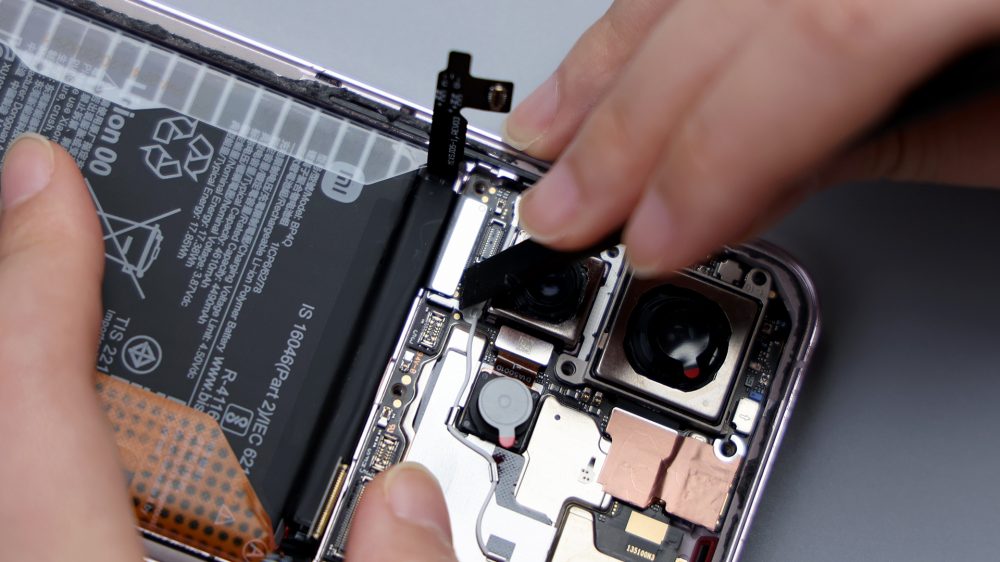
Tear off the copper foil at the top center position, disconnect the BTBs of the front and rear four cameras in turn, and remove the lens.
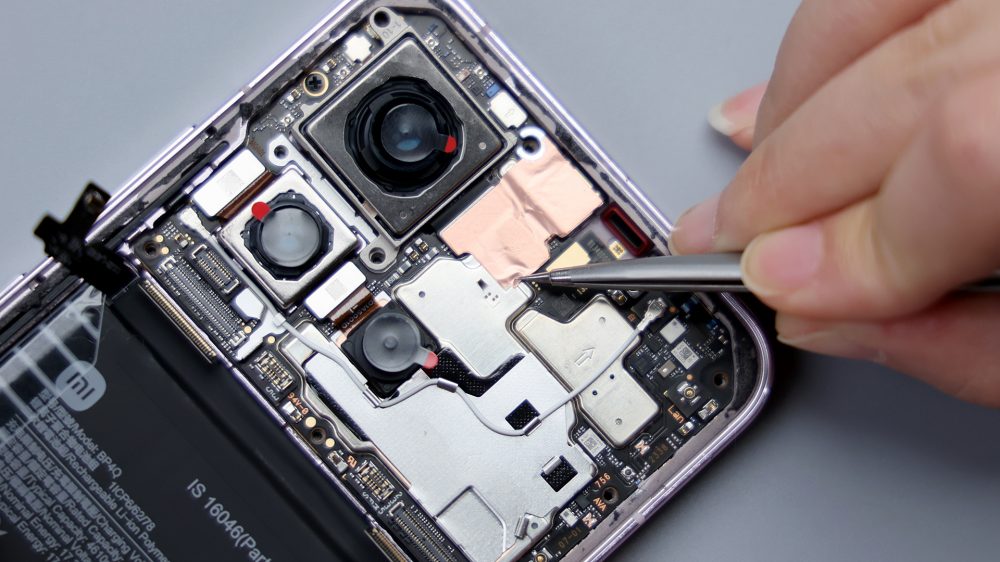
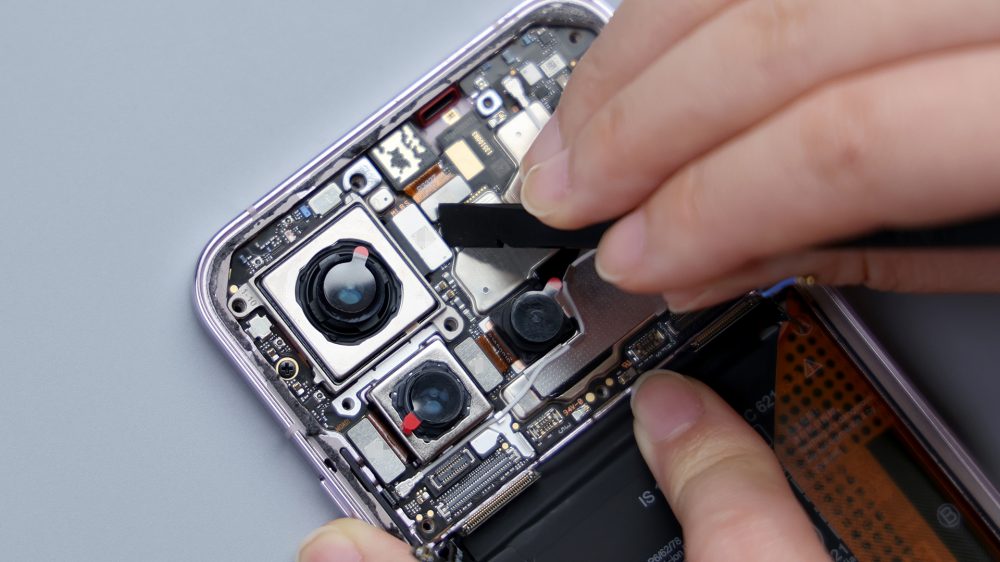
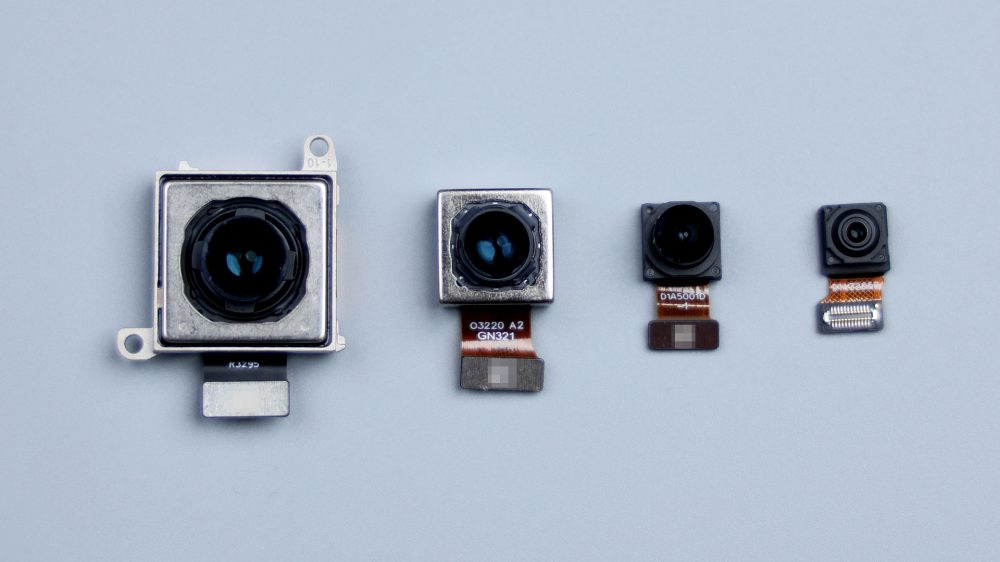
The sensors of the Xiaomi 14 front and rear four cameras are the same as those of the 14 Pro, except that the detailed parameters, tuning and functional features are slightly different.50 megapixel ultra-dynamic main camera, Light Hunter 900 customized image sensor, 1/1.31-inch outsole, support for OIS optical stabilization, equivalent focal length of 23mm, compared with the 14 Pro, the variable aperture function was canceled, and the aperture was fixed at f/1.6, the 7P coated lens. 50 megapixel floating telephoto lens, Samsung JN1 sensor, this lens is also very widely used, many brands of the main models are fitted with the JN1, support for OIS optical stabilization and EIS electronic stabilization, equivalent focal length of 75mm, the closest focus distance of 100mm, aperture f/2.0. 50 megapixel ultra-wide-angle lens, with the same Samsung JN1. Equivalent focal length of 14mm, aperture f/2.2. 32-megapixel front-facing lens, from the OV32B sensor of Howell Technology, up to support 4K/60fps video shooting.
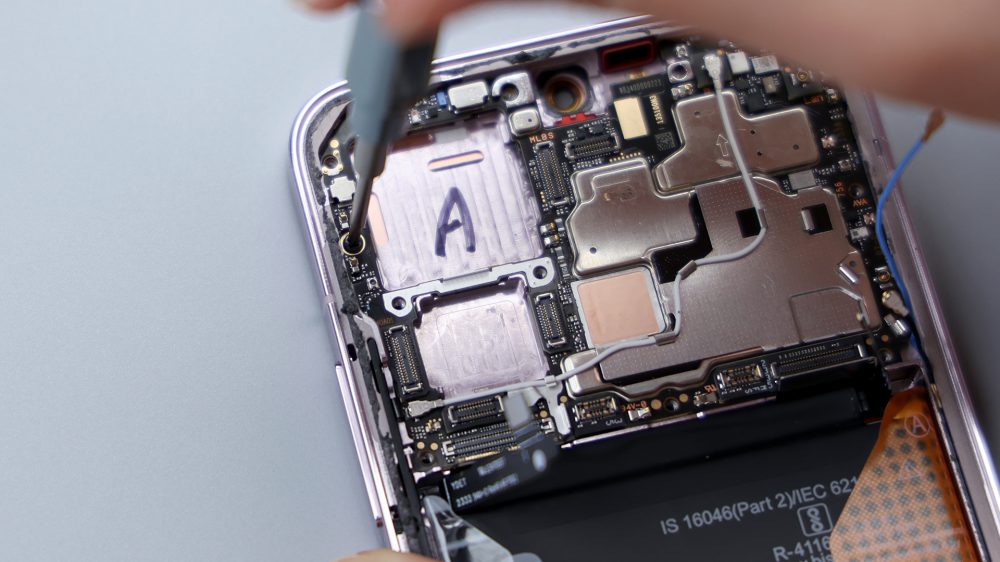
Unscrew the motherboard's retaining screws and pry up to remove the motherboard, disconnecting the white coaxial cable in the process.
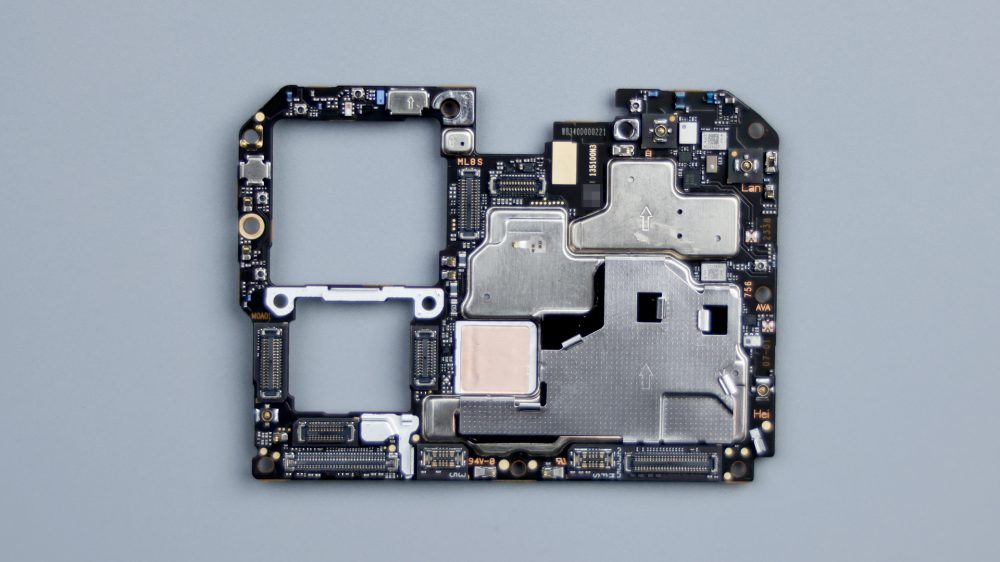
The shield underneath the A-side of the motherboard is removable and has a large graphite thermal paste pressed underneath.
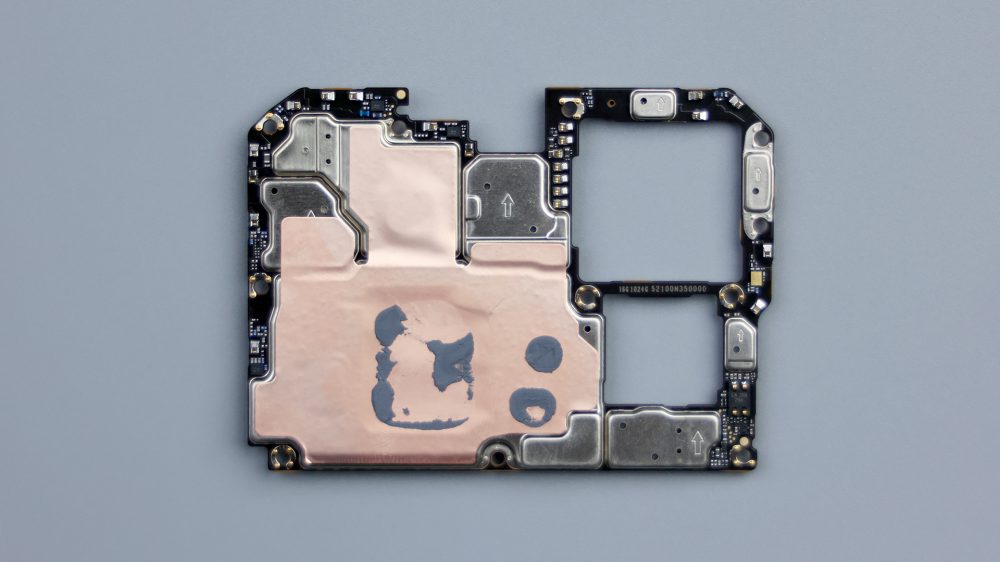
Most of the B-side is covered with copper foil, and silicone grease has been added to assist with heat dissipation for the core heat generators.
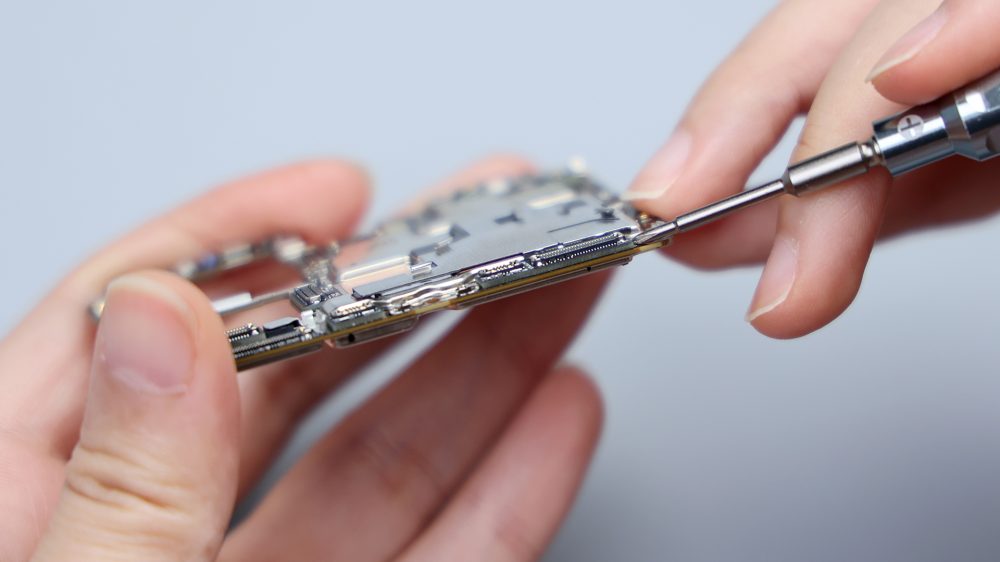
From the side, you can see that the bottom row of three BTBs, and the two lens BTB base, including the two coaxial cable ports in the upper right corner of the stacked padding treatment, while the motherboard as a whole is still a single-layer design, PCB is very thin, on the one hand, can minimize the longitudinal space occupation, to control the thickness of the fuselage, on the other hand, a single layer of the motherboard is also more conducive to heat dissipation.
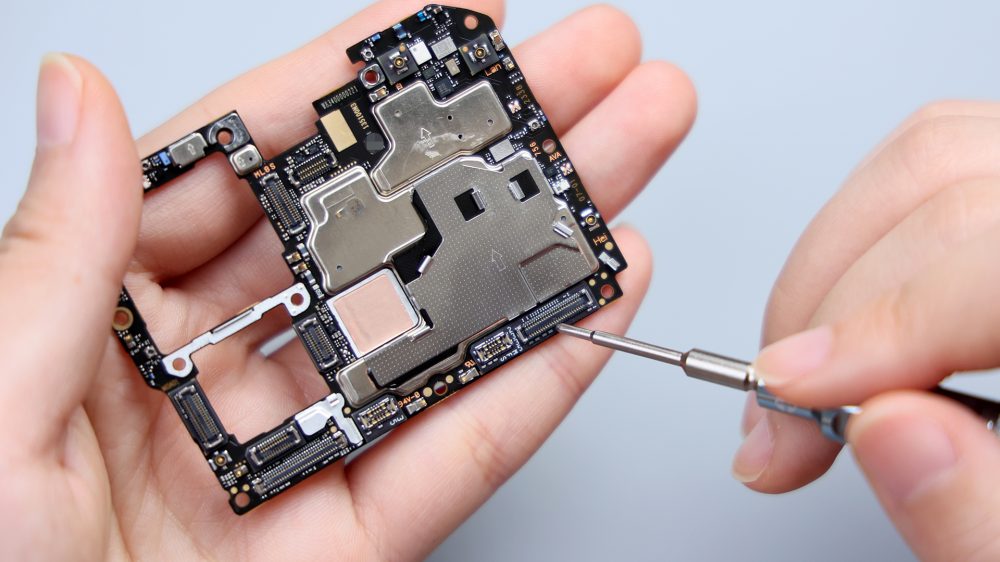
Taking into account the rigidity of the PCB, in the motherboard is relatively narrow and relatively weak position, with a metal sheet to do the reinforcement protection.A side of all the BTB base are not set up rubber ring or foam ring, which is also the consistent tradition of xiaomi, the protection of the task are handed over to the cover of the inner side of the foam pads, capacitors and small parts are also not spot glue, these aspects of the work is not as meticulous as the OV two families. Next to the coaxial cable interface, there are corresponding color markings, white with Chinese characters, black and blue with pinyin, easy to distinguish between assembly and maintenance, to avoid connecting the wrong.
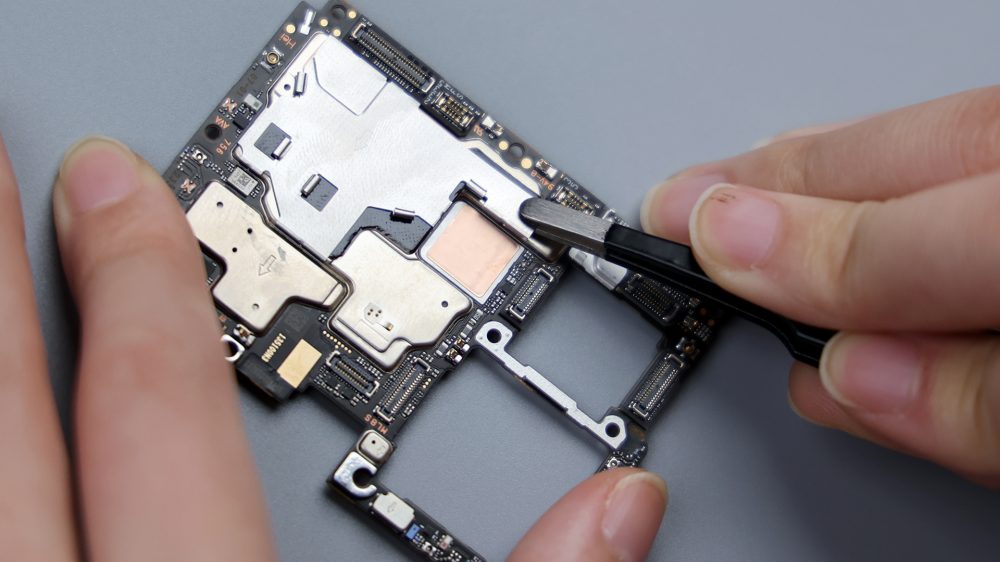
Pry open the motherboard shield, tear off all the copper foils and graphite heat dissipation stickers, and most of the chips have separate silicone grease and heat-conducting silicone sheet to assist in heat dissipation.
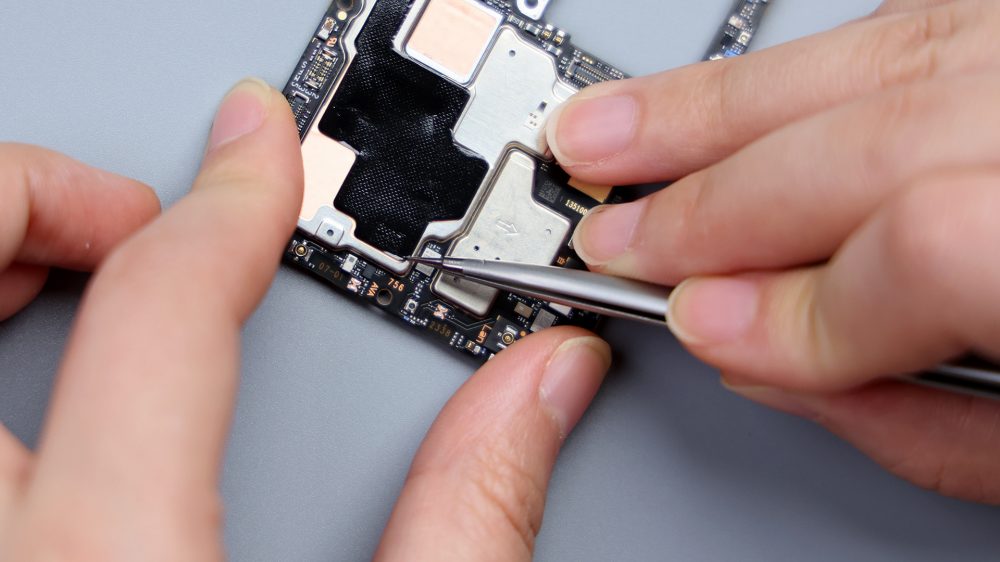
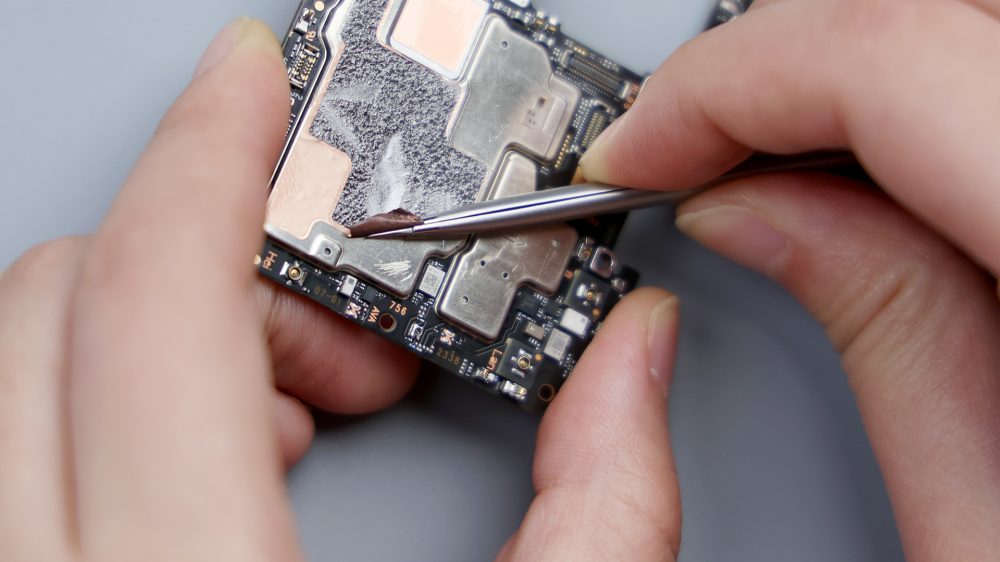
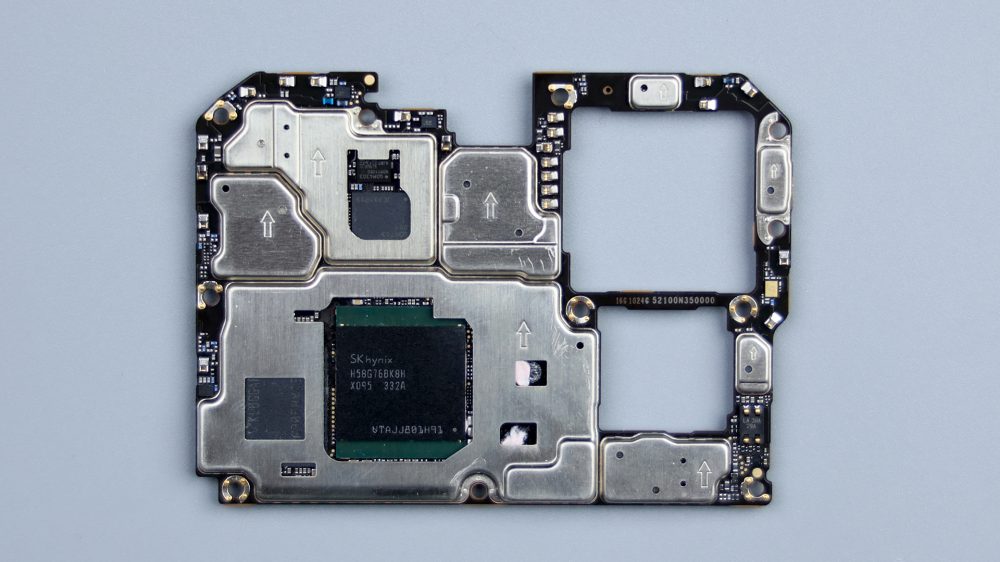
On the B-side of the motherboard, printed with the Hynix logo, is 16GB of LPDDR5X running memory, the larger chip pressed underneath it is the Snapdragon 8 Gen 3 processor from Qualcomm, the slightly smaller chip on the left is Samsung's 1TB of UFS4.0 flash, the one in the lower-right corner is Xiaomi's self-developed Surge P2 charging IC, and the chip immediately above the processor is the Qualcomm SDR753 RF IC, and under the shield on its right, a Qualcomm WCN7851 WiFi/Bluetooth chip.
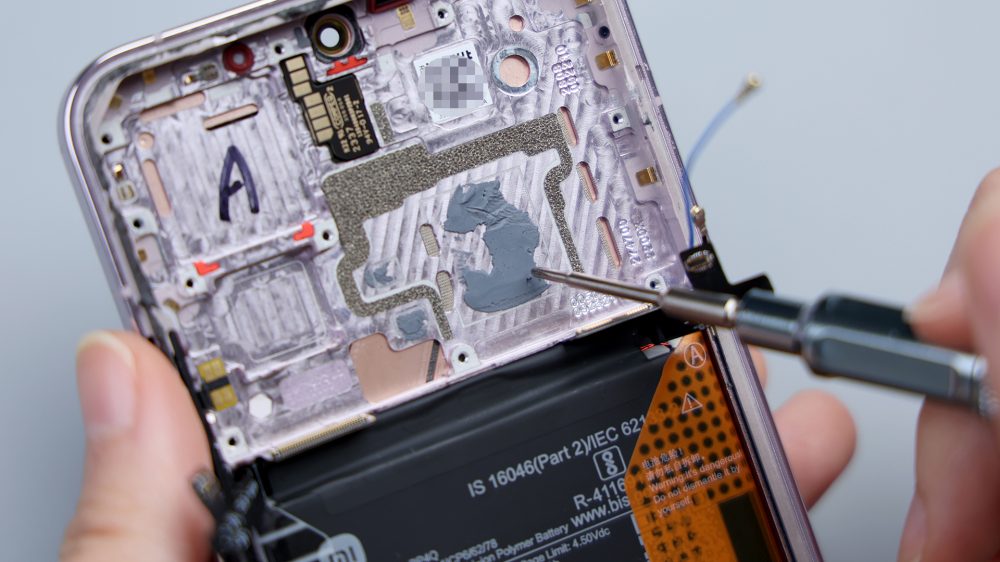
On the empty center frame roll cage, you can still see the residual silicone grease, four contacts in the lower left corner correspond to the power and volume buttons, the copper sheet distributed around the periphery is responsible for the signal overflow, the round red rubber ring corresponds to the top microphone, and there is a foam ring cushion to protect the position of the front lens. There is a small piece of PCB on the lower left side with the logo "COMPEQ" printed on it, and after prying it up, you can see that there is an ambient light sensor integrated on the back.
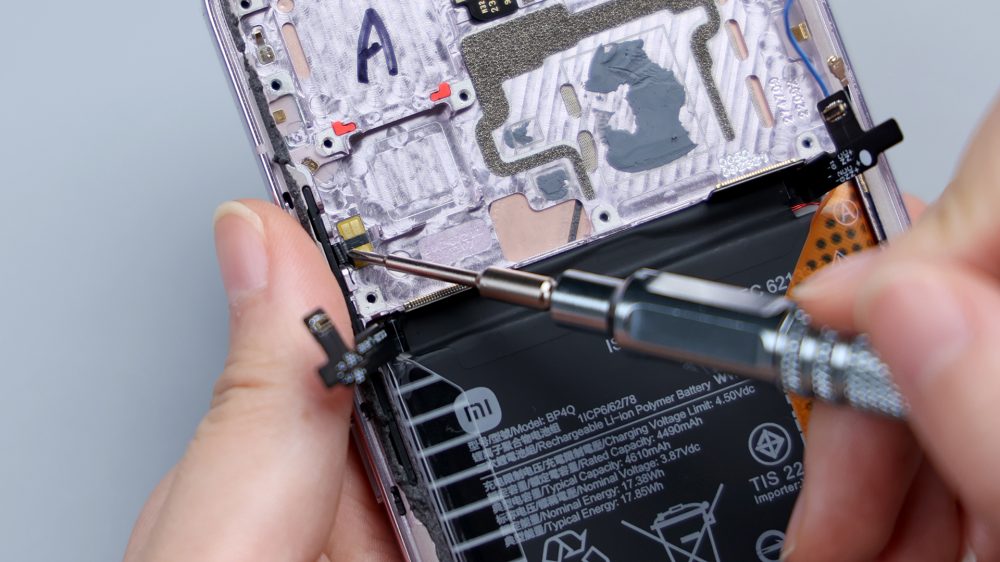
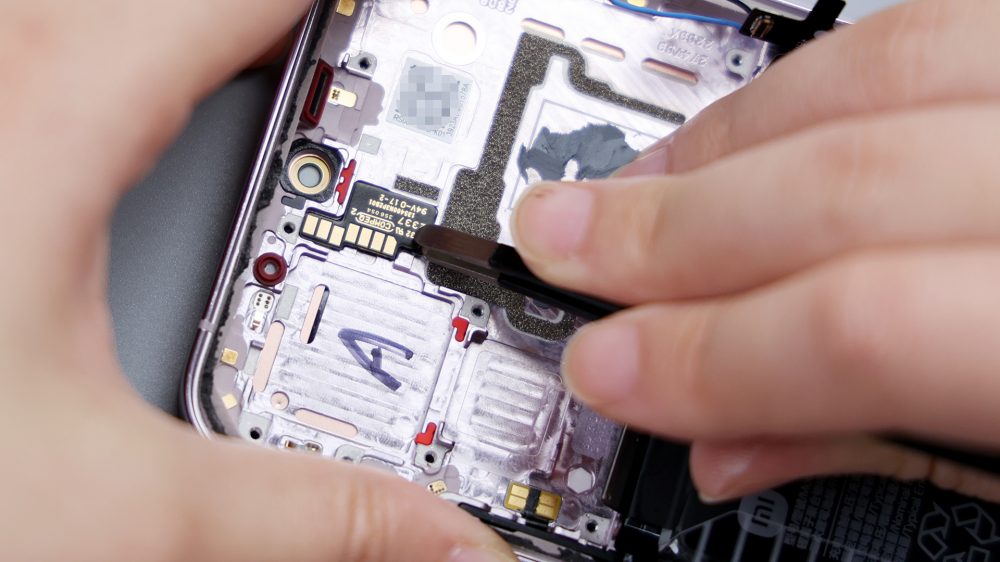
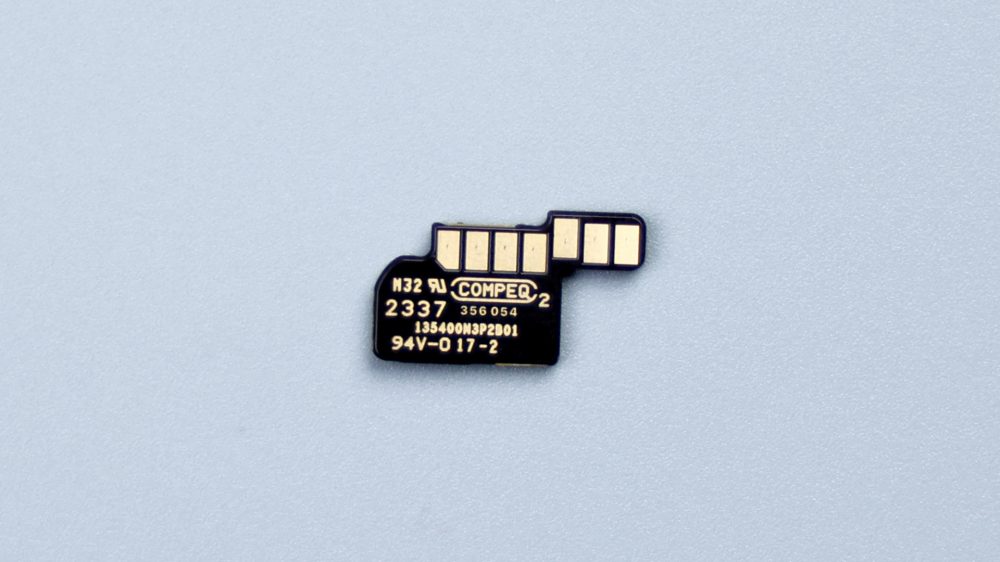
Turning to the bottom, unscrew all the fixing screws at the bottom, pry up the cover of the sound chamber, and pay attention to the back side there is a small plate, connected to the black coaxial cable, do not yank it off.
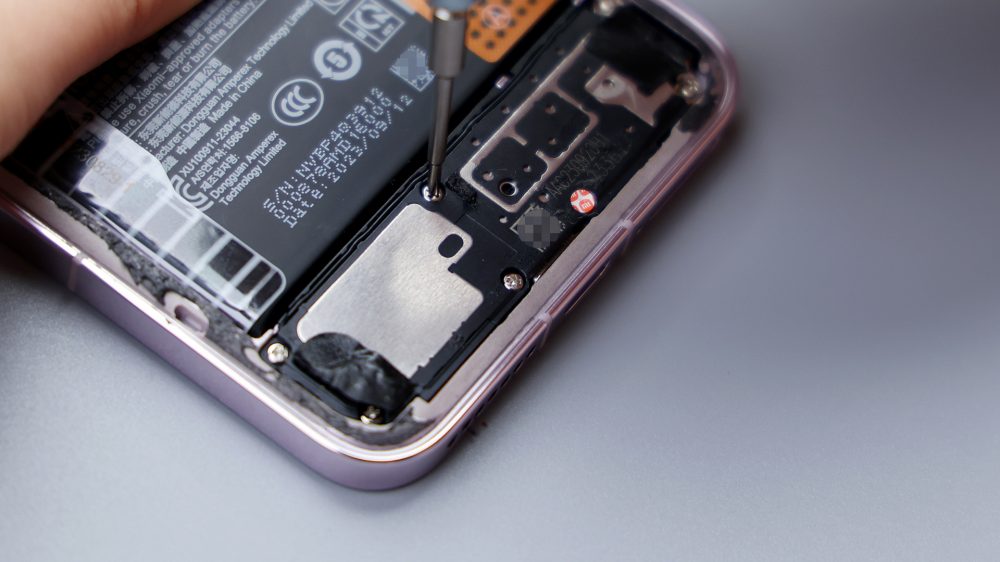
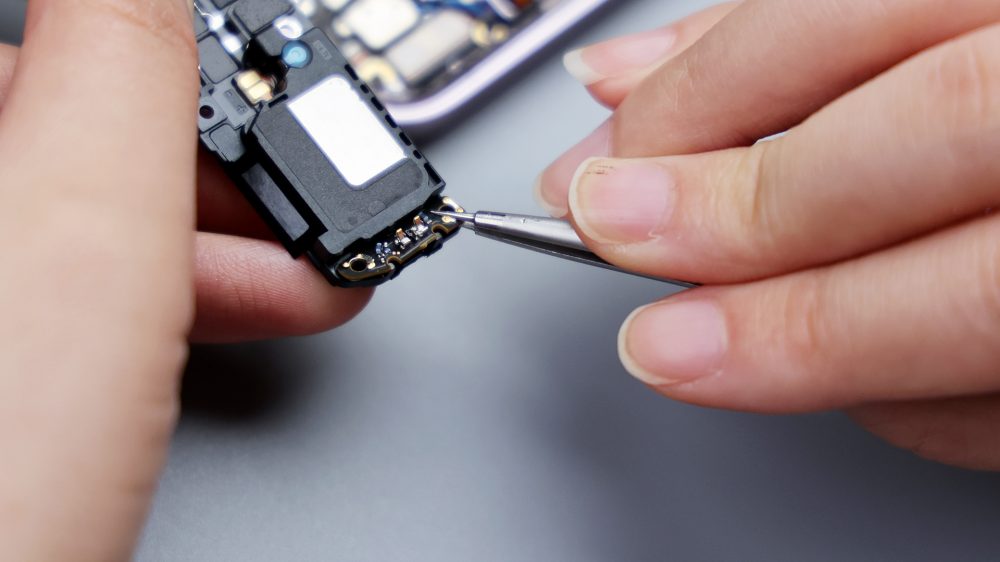
Like the motherboard area, the bottom cover plate has multiple foam pads on the inside, and the sound chamber is an 1115K from Rasonic Technology, which is connected to the secondary board via 2 contacts.
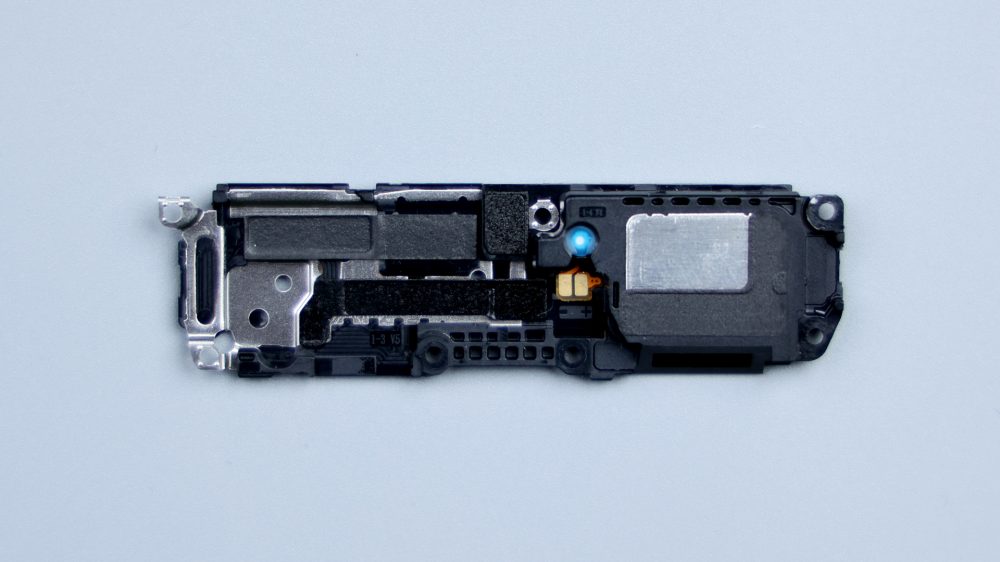
Disconnect the blue coaxial cable, fingerprint identification module, main and sub board FPC and screen BTB in turn, pry up and remove the sub board.
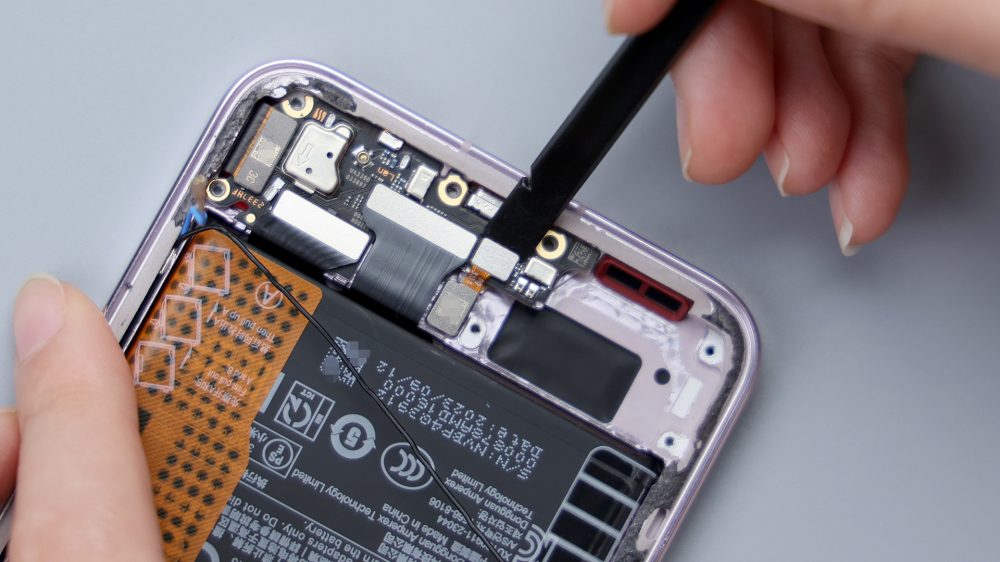
The PCB supplier is Shenghong Technology, which specializes in the development, production and sales of high-density printed circuit boards and is headquartered in Huizhou City, Guangdong Province. The BTB base on the secondary board also has no foam ring, and the capacitors are not dispensed.
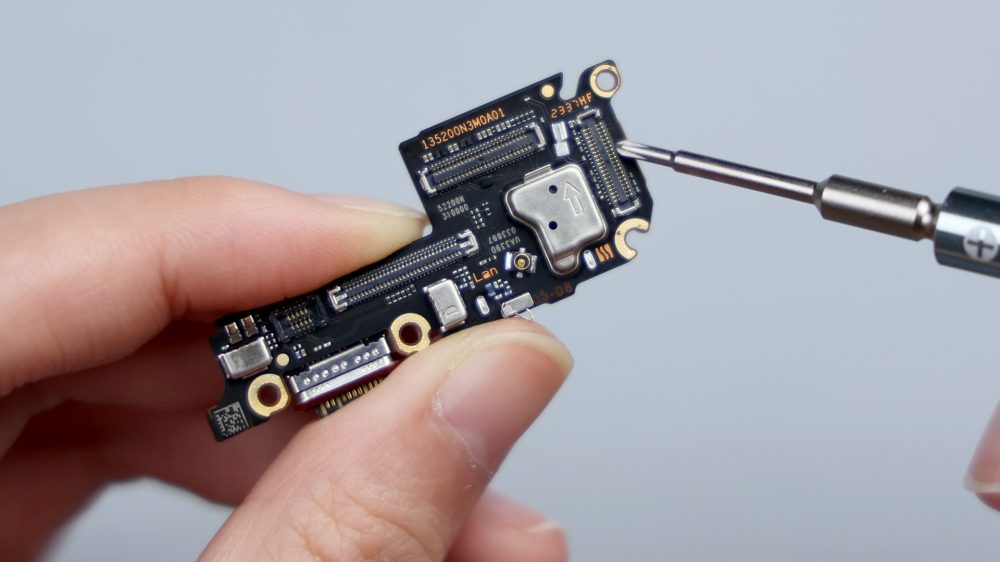
The shape and layout of the entire subboard is similar to that of the xiaomi 14 Pro, and both are equipped with two microphones, plus two in the main board area, which means that the Xiaomi 14 adopts a four-microphone configuration, which lays the hardware foundation for excellent sound collection. The difference between it and the 14 Pro is mainly focused on the USB interface, dustproof and waterproof rubber ring is definitely there, only the Xiaomi 14 has integrated the interface in the secondary board, in addition, the interface standard and transmission rate is also different, Xiaomi 14 is USB 3.2 Gen 1 standard, the transmission rate of 5Gbps, the Xiaomi 14 Pro configuration half a gram higher, using the USB 3.2 Gen 2 standard, the transmission rate is 10Gbps, exactly double the difference. However, compared to the USB 2.0 of the previous generation Xiaomi 13, it is definitely a big step up.
The shape and layout of the entire subboard is similar to that of the 14 Pro, both of which are equipped with 2 microphones, plus the 2 in the main board area, which means that the Xiaomi 14 adopts a four-microphone configuration, laying a hardware foundation for excellent sound collection. The difference between it and the 14 Pro is mainly focused on the USB interface, dustproof and waterproof rubber ring is definitely there, only the xiaomi 14 has integrated the interface in the secondary board, in addition, the interface standard and transmission rate is also different, xiaomi 14 is USB 3.2 Gen 1 standard, the transmission rate of 5Gbps, the 14 Pro configuration half a gram higher, using the USB 3.2 Gen 2 standard, the transmission rate is 10Gbps, exactly double the difference. However, compared to the USB 2.0 of the previous generation Xiaomi 13, it is definitely a big step up.
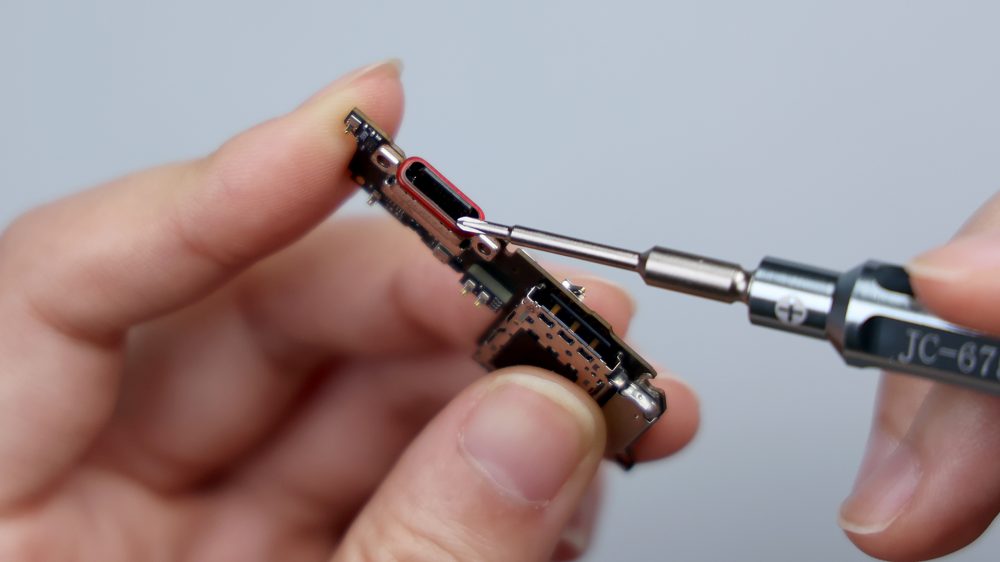
Here by the way, the interface standard upgrade, before the market most of the cell phone interface is still stuck in the USB 2.0 standard, it is caused by multiple factors, one of which is the cost of allocation and the actual utilization of the pull, now the use of Android user habits with more than a decade ago is not the same, the early users will often transfer data between cell phones and computers, the utilization of USB interfaces Relatively high, but nowadays, users are basically out of the wired data transmission, most of the cases are through the network to download, cloud call or WiFi network to each other and other ways to transmit data. You can think back to their own use of cell phones in recent years, you can also ask people around them, how long they have not used the data line to connect the computer to transfer data, it is estimated that most people may not be used once a year, or even, the cell phone to the elimination of the phone, may not have connected to the computer. Even if the use of data cable transmission, regardless of the previously mentioned 14 and 14 Pro double the rate difference, or with the USB 2.0 rate difference, only the transmission of a single large file, or a huge number of small files, in order to feel the obvious difference, if only dozens of hundreds of megabytes, the average user is not to notice the difference. So, in this case, the manufacturer will weigh, in the case of limited cost, is the priority to upgrade the interface data transfer rate, or priority fast charging rate, the answer is obvious. In addition, there is another point to note, you think the interface standard upgrade to USB 3.2, you can enjoy the corresponding transmission rate? Too naive! Want to increase the transmission rate, not only the interface to upgrade, the cable should also be upgraded, to match the USB 3 dedicated cable to work, and xiaomi 14 and 14 Pro box comes with a standard cable does not support USB 3 transmission, that is to say, want to increase the speed, but also have to spend money to buy a line, this part of the information, xiaomi official website did not hide, only the note prompted a little smaller, I guess most people look at the parameters of the time will not notice that there is also a line below. I guess most people look at the parameters of the time will not notice that there is such a small line below. See this, there may be small partners will ask, why not directly standardized USB 3 cable? Because ...... have to add money! With the "interface standard upgrade is difficult" for the same reason, it is still the cost allocation and actual utilization of the pull of the problem, in the end, or money. Imagine, the interface standard upgrade have been waiting for so many years, that standard USB 3 cable, how much longer to wait?
The disassembly continues, the vibration unit is fixed to the bottom frame by adhesive, pry up with tweezers to remove it, it comes from Ruixing Technology, model ESA0809, slightly thicker than ELA0809.
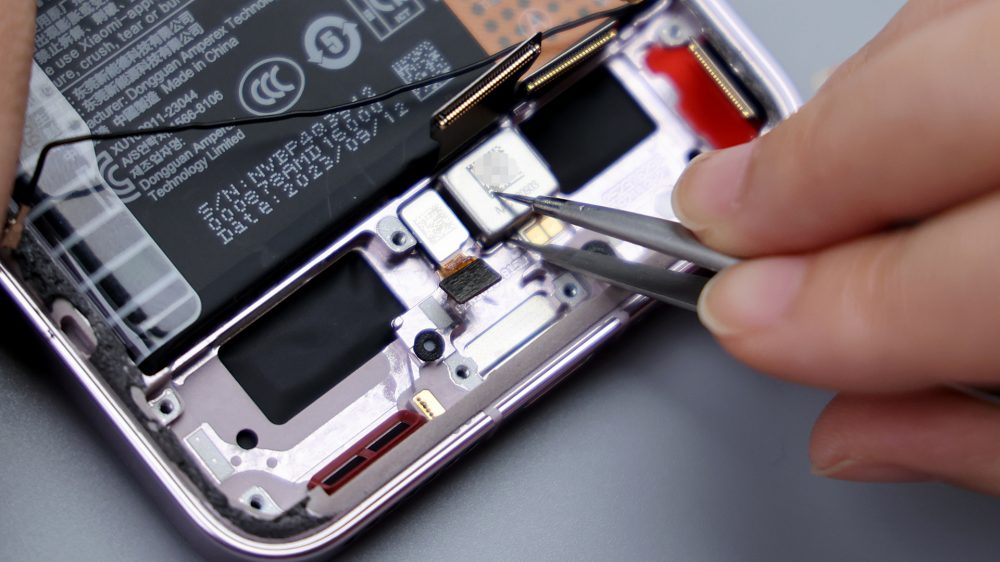
The fingerprint recognition next to it also uses adhesive, and there are two limit posts, you can't be too hard when removing it, and the screen fingerprint of the Xiaomi 14 uses a short-focus lens solution. On the empty frame, there is an airtight rubber ring at the location of the sound hole, and there is a cushioning foam at the location of both microphones.
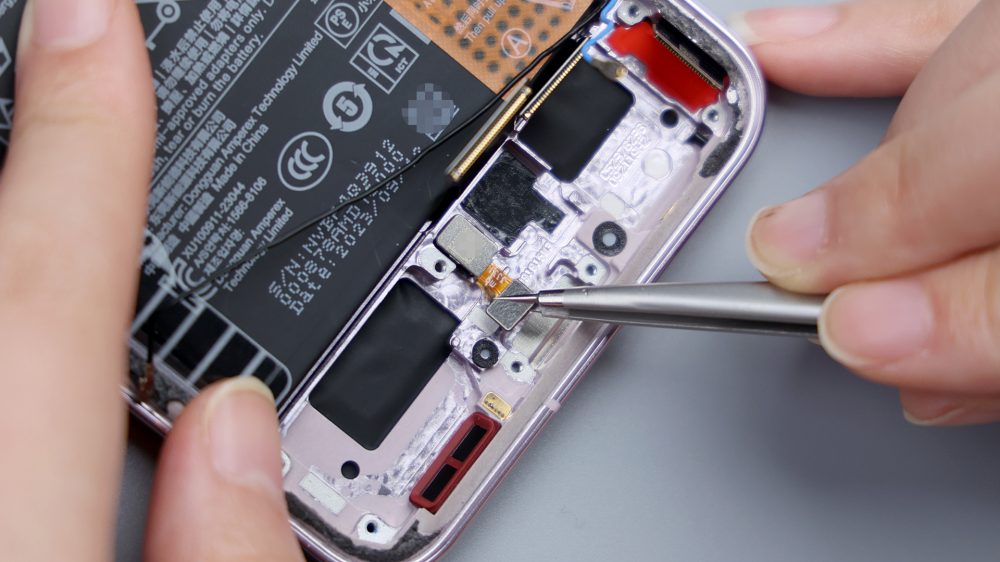
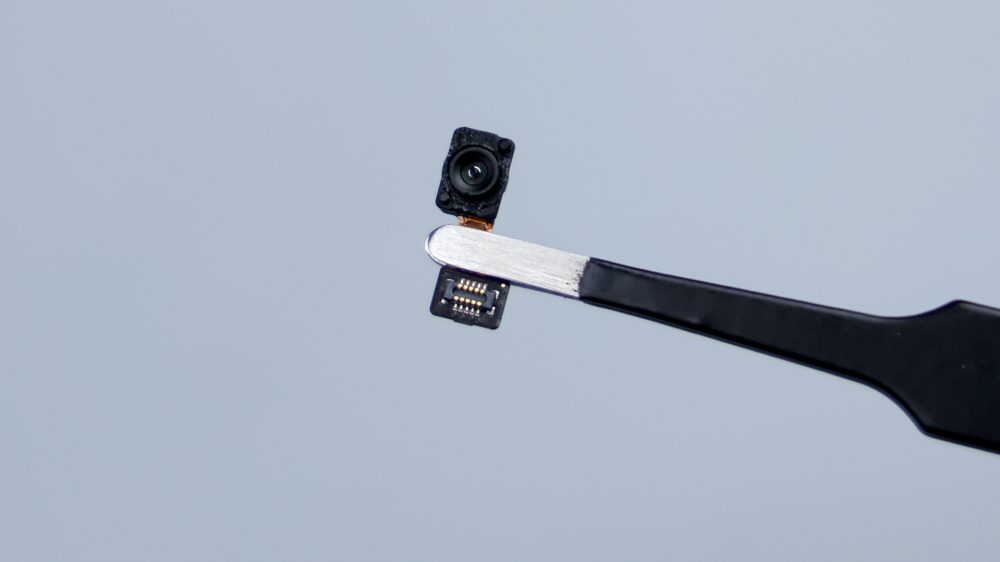
The battery is designed with an easy-pull quick release, tear the tape according to the illustration and lift it upward, and it is easy to take out the battery.
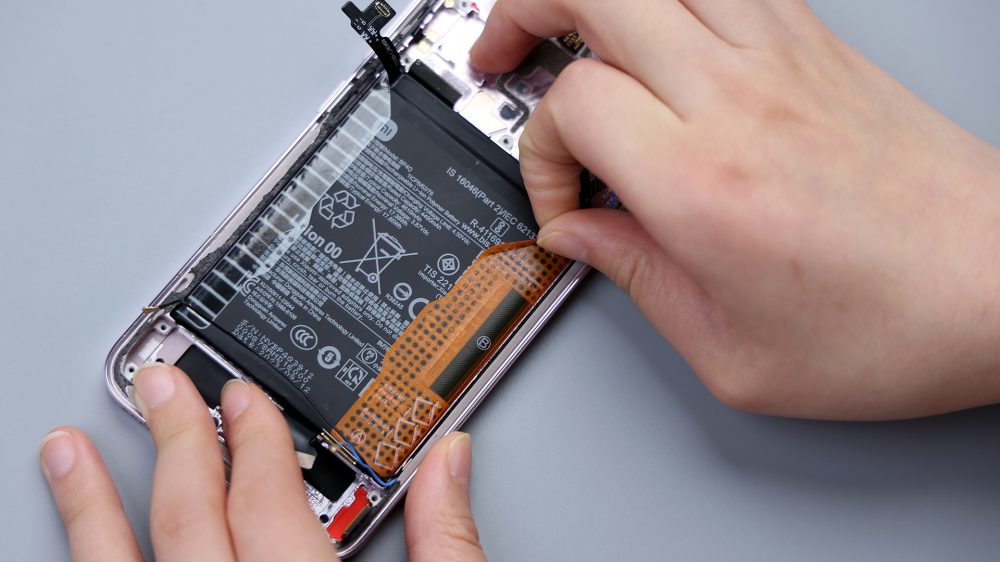
It uses a single-cell dual interface program, the recent xiaomi and Redmi's mid-range and high-end models are almost all this program, above the package of a thin PCB, built-in a xiaomi self-developed Surge G1 battery management chip, the thin red line in the upper right corner, is the NTC temperature sensor. The battery capacity of 4610mAh is 110mAh more than the Xiaomi 13 and 270mAh less than the Xiaomi 14 Pro, which is not a clear advantage of the 14 Pro from the perspective of battery life. Its manufacturer is Dongguan Xinnengde Technology Co. Ltd, and from the labeling on the back, its cell supplier is ATL, or Ningde New Energy.
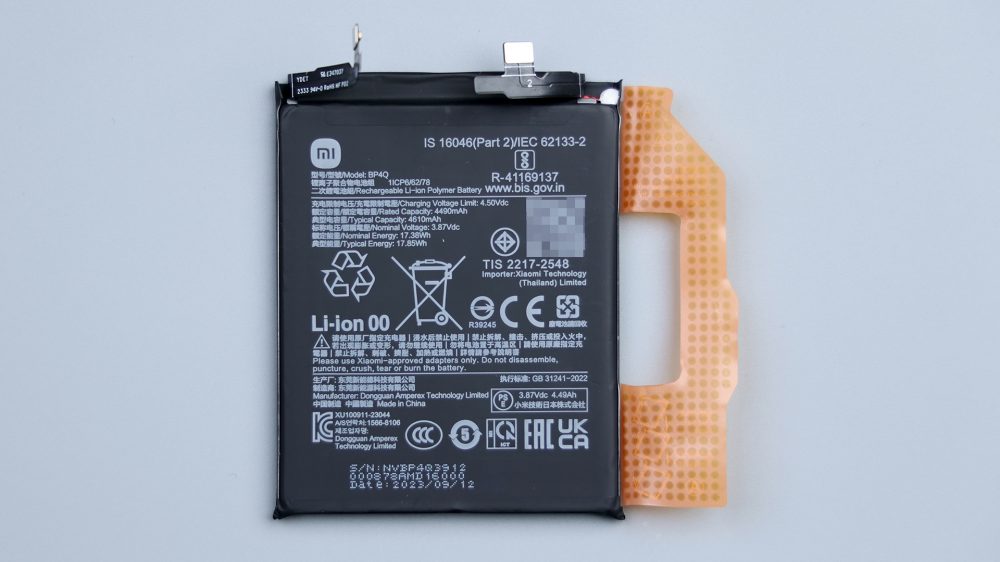
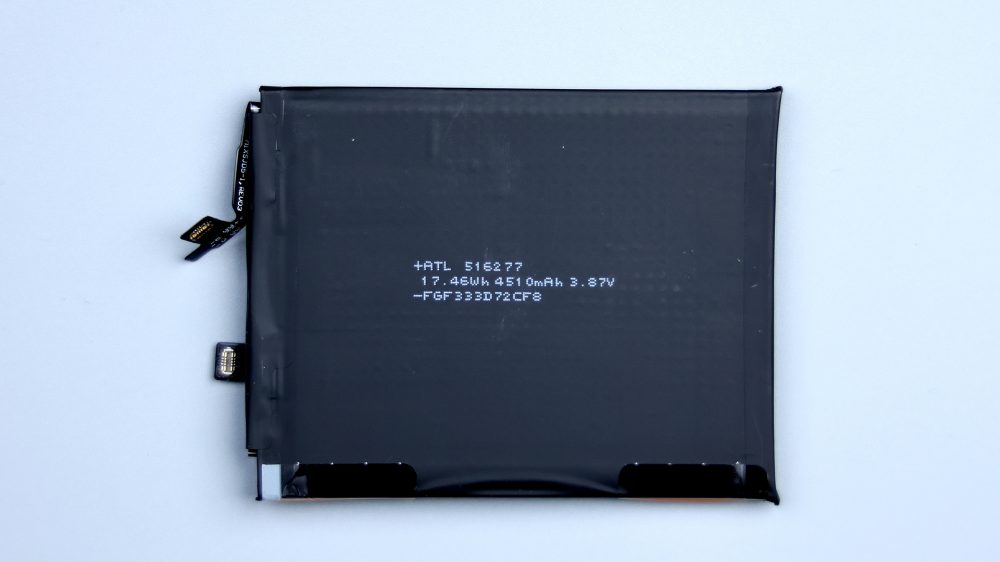
By this point, the disassembly of the Xiaomi 14 is basically complete. As the standard version of the new generation of Xiaomi digital series, from it we see that the product positioning and internal ID design drive and enable each other.
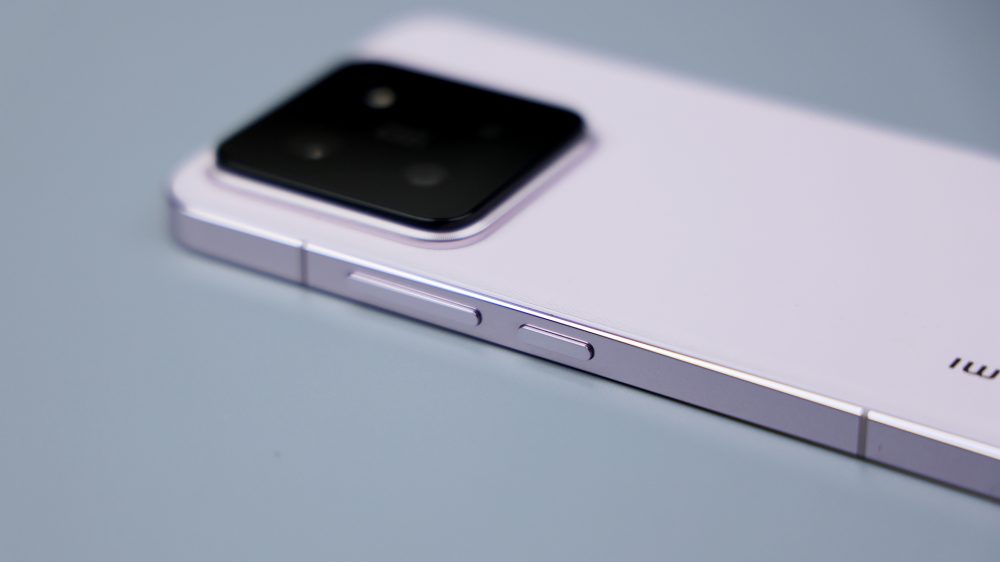
All parts of the Xiaomi 14 reflect a strict control of space occupation, from the back cover to the DECO, from the cover to the motherboard, and from the sound chamber to the sub-panel, all of which are being integrated as much as possible. On the positive side, this is determined by the 14's product positioning, which is positioned as a small-screen flagship, with a "6.36-inch golden size, extremely narrow visual quad-quadrilateral screen", which are both the main selling points and configurations that serve the small-screen flagship positioning.
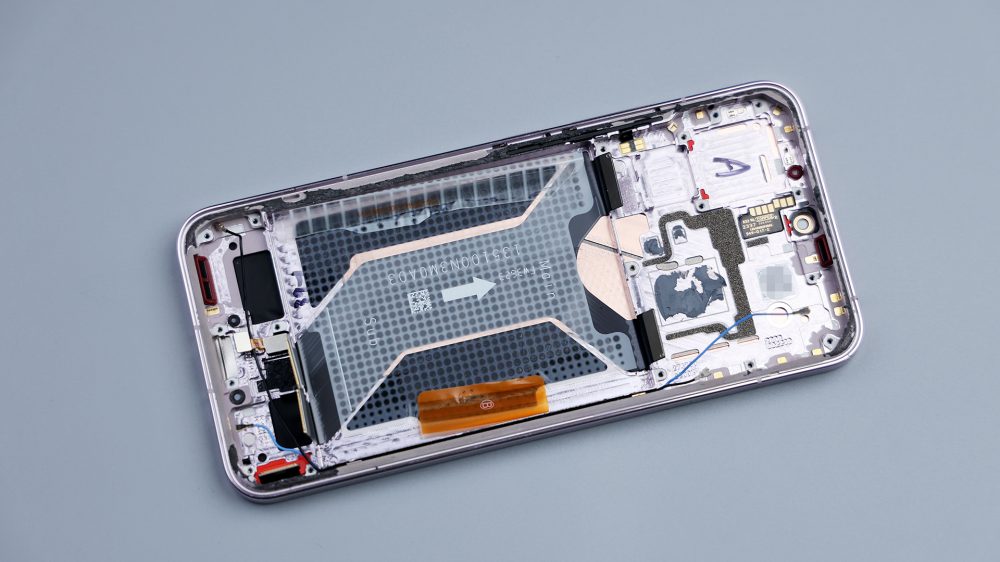
Positioning is well chosen, equivalent to drawing a box, it pushes the structural engineers to complete the topic. And from the reverse point of view, it is because of those parts we mentioned earlier, joint efforts and promotion, and ultimately to achieve an ideal circumference size and comfortable grip feel, the achievement of a classic small screen flagship, sales data and user reputation is the best proof.
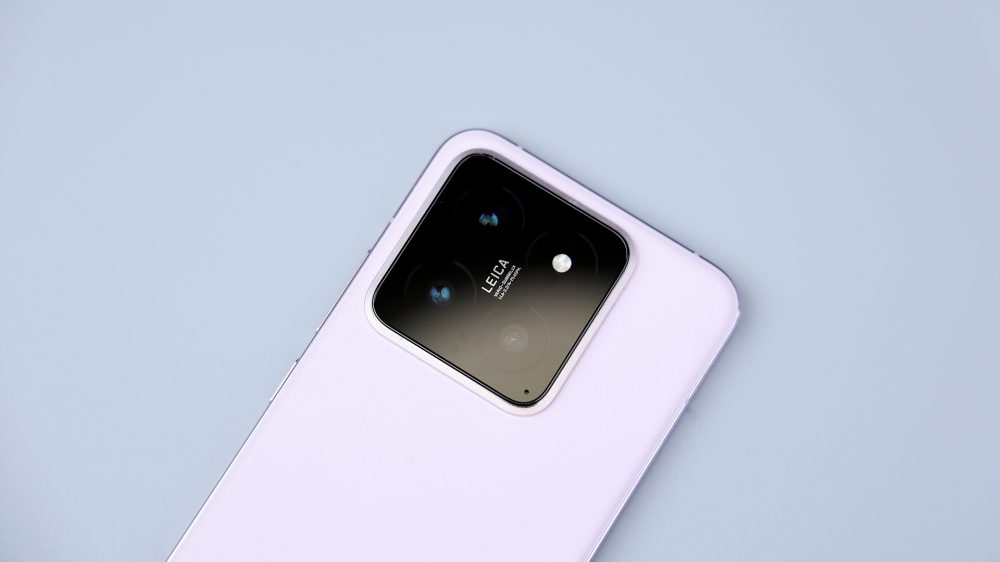
Through disassembly it is not difficult to find that the internal structure, ID design, materials and workmanship of the Xiaomi 14 and 14 Pro are very close to each other, and the gap is not too big, and from the perspective of purchasing, I think that the Xiaomi 14 is more cost-effective.
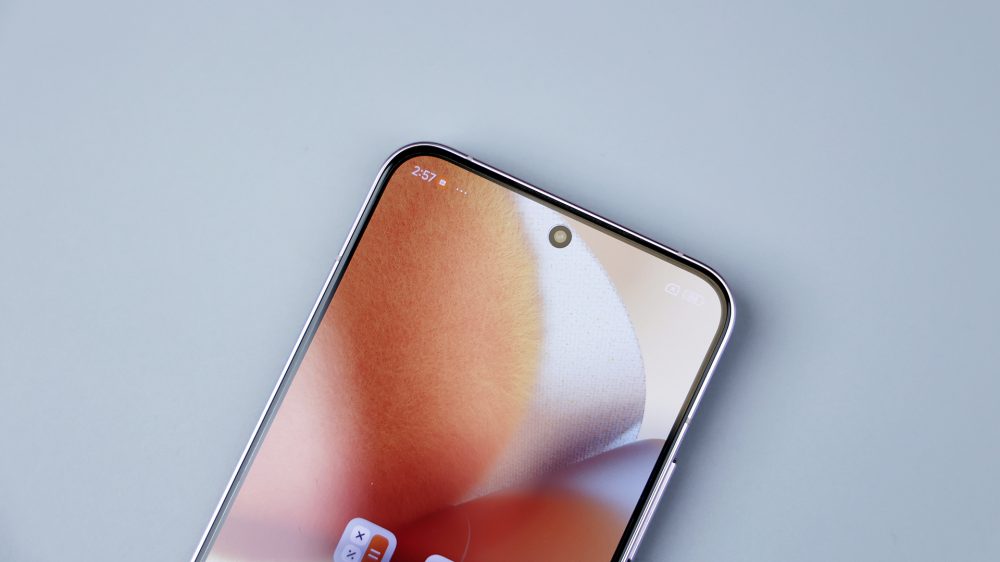
There are two main reasons for this, firstly, being the standard version, the Xiaomi 14 does a strong enough job, it is a flagship with excellent overall performance and no obvious shortcomings. Secondly, being the enhanced version, the enhancements of the Xiaomi 14 Pro are not obvious in the various daily use scenarios that bring the actual plus effect, and even not used in many cases, which is embarrassing. Simply summarized is that, regardless of performance, functionality or experience, xiaomi 14 for most ordinary consumers, are enough to use, 14 Pro most of the enhancement, can only be regarded as the icing on the cake, and there is no qualitative enhancement, this time the standard version can be described as a superb value, while the Pro version can only be said to be barely qualified for a small enhancement version. In this regard, some netizens teased, Apple's strategy is that the Pro version of all aspects of the best, and then use the precise method of castration of a standard version, xiaomi this time the opposite, the standard version of the standard version of the direct pull to the top of the level, and then "carrot carving", do some minor upgrades, to get a Pro version out. After a comparison found that the only thing that can affect the purchase decision of these two phones, there is only the screen, I think this is the biggest difference between the two of them, but also the only part of the gap can not be ignored (here the screen directly put the comparison charts), because not everyone likes a small screen, and it is impossible for everyone to like a straight screen, coupled with the difference in resolution and the glass cover. So, in the actual purchase process, these two phones two choose one, just look directly at the screen, for those who have a preference for large or curved screen, choose 14 Pro, if you have no feeling for them, just choose 14.
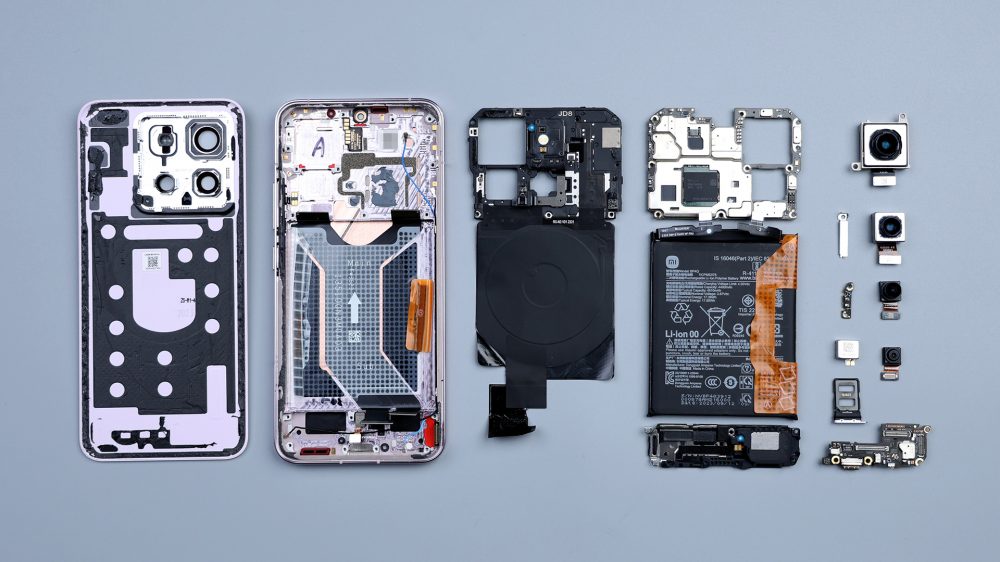
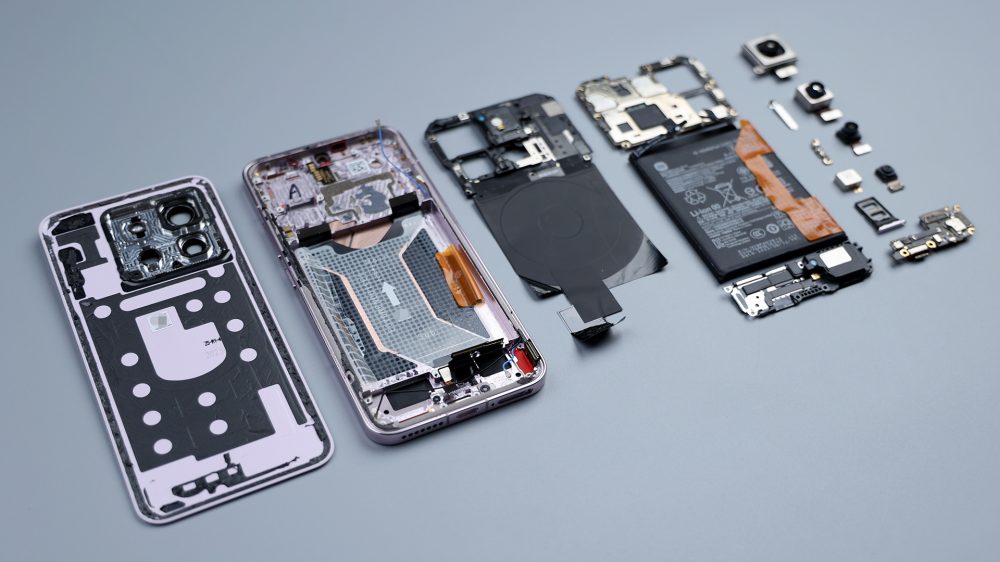
As usual, I'm going to end with a disassembly-related topic, which is the aforementioned laser welding. At present, the use of this welding program to assemble DECO Android phones is not common, I came into contact with only xiaomi 14 and xiaomi 14 Pro. recent generations of iPhone lens cover, also used laser welding technology, only, due to the differences in the main structure of the phone and the ID design, the specific details of the assembly is slightly different, for example, the iPhone 15, the overall frame of the back cover is made of metal, the lens cover by laser welding. is made of metal, and the lens cap is fixed on the frame by laser welding technology. Although laser welding DECO not many cell phones, but this welding technology, has long been widely used in cell phones, cell phones in recent years, can see its figure, such as responsible for the antenna signal overflow shrapnel and contacts, the middle frame of the metal frame of the parts, screws bit, metal anti-roll frame parts, as well as the USB interface, a lot of them are completed by laser welding, in the iPhone is more Can be seen everywhere, large to the center frame welding, small to the buckle welding, with this technology. Now a lot of large cell phone repair stores, have also purchased laser welding equipment, mainly for the repair of the iPhone when used, such as the lens cap replacement mentioned earlier, aluminum alloy frame and stainless steel sheet welding, as well as in recent years the more fiery iPhone battery transplantation core, are completed by laser welding.



